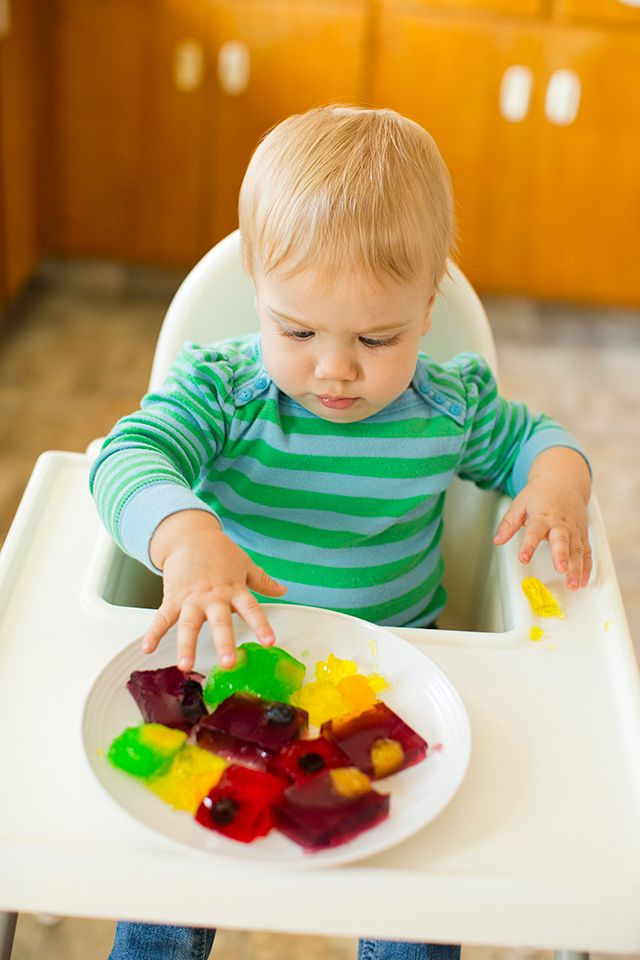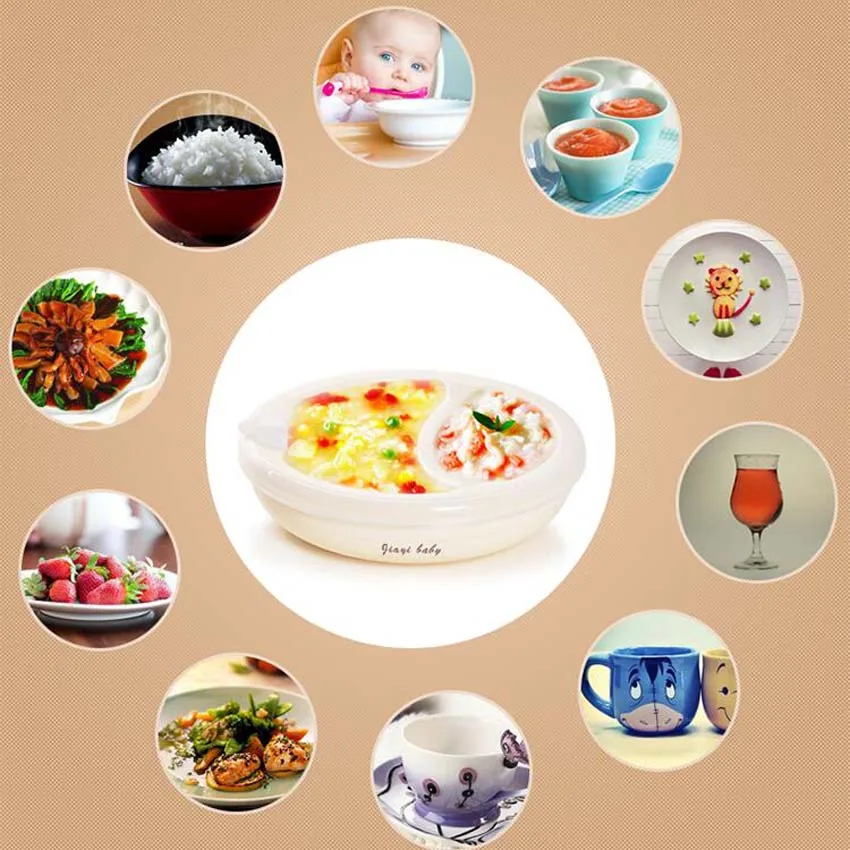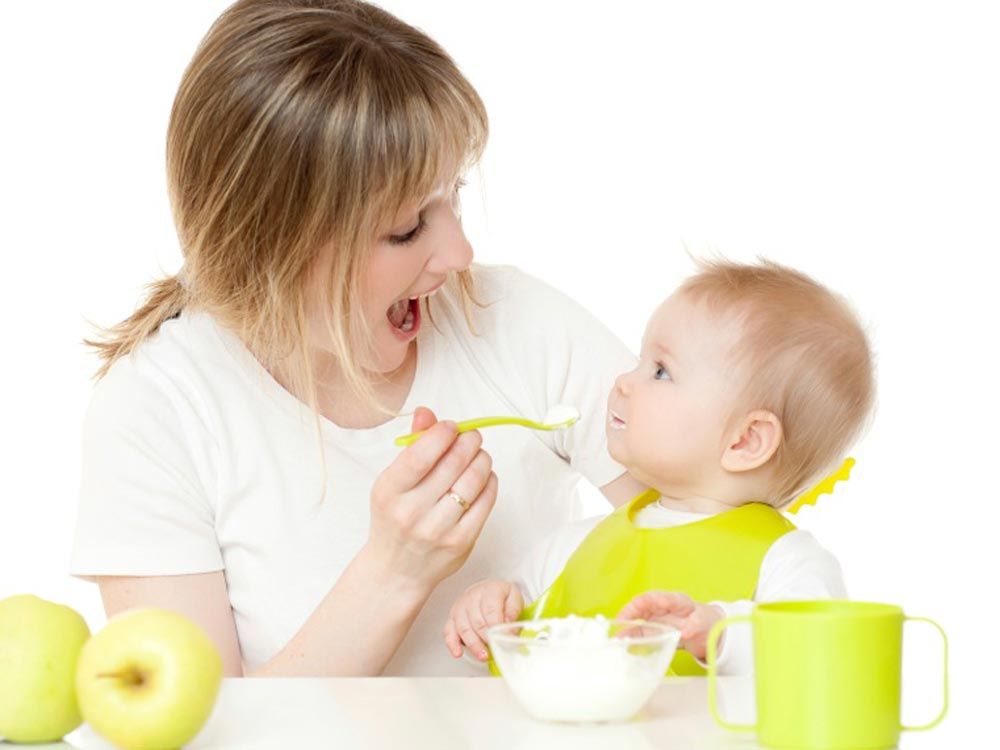Introducing textured food to baby
Textured Foods: How to Transition Baby from Puree to Table Food
Is your baby refusing to eat food other than purees? Not sure how to introduce textured foods to your baby? Here are some expert tips from a registered dietitian.
Contents
When to Move to Textured Foods
Generally speaking, most babies are ready to transition from purees to textured foods between 6-9 months.
Is your baby 6 months old and up?
Learn all the secrets to starting solids safely while optimizing nutrition!
I NEED IT NOW!
If you decide to take the baby led weaning approach, then your baby will learn to handle textures from the start.
If you’re starting out with purees, it's best to keep this stage pretty short. That’s because research shows that infants who are introduced to textures by 9 months generally have less feeding problems and greater food acceptance down the road.
Therefore, you need to gently challenge your baby with new food consistencies. Otherwise, they will get used to just swallowing and not learn to move food around in their mouth and chew. All this leads to an increased aversion to textures.
If you haven’t decided which feeding method is right for you and your family, then check out this post - Starting Solids - Purees vs. Baby led weaning.
And remember, babies don’t need teeth to chew! It's amazing what their gums are capable of!
The Benefits:
- Increased acceptance of variety
- Strengthening of baby’s jaw muscles
- Promotes speech development
How to Transition to Table Food
First, if you've started on purees and feel stuck, allow me to guide you!
Every child is different and contrary to what you may have been told, you don’t necessarily have to introduce textured foods in any specific order or stages. Everything you see in the visual is appropriate and safe to serve to your baby.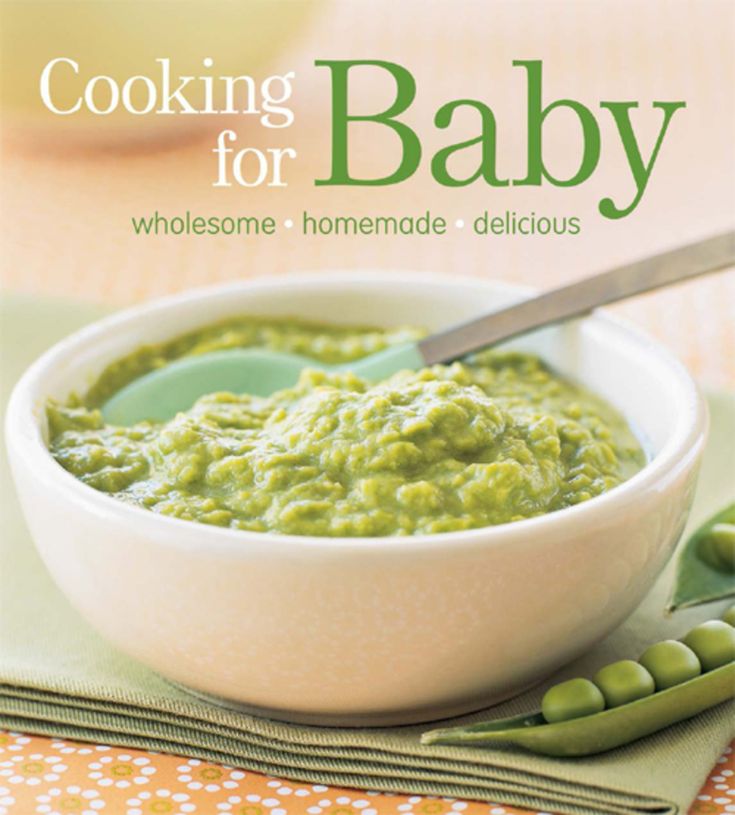
But your baby or you might need the gradual progression. Perhaps your baby has a very sensitive gag reflex or other underlying issues. ALWAYS do what feels best and comfortable for you and your family. Just remember not to stay at any one stage for too long.
You can start by thickening the baby purees to encourage the use of the tongue and muscles in the mouth to start the chewing process. This can be accomplished by adding less water or liquid when pureeing.
If you've been spoon-feeding, try preloading the spoon (here's one that I highly recommend!) and either place on the table or hold it out for them to grab.
Then move onto lumpy to mashed to soft minced and chopped up foods along with soft finger foods. Here are easy ways to incorporate vegetables for babies 6 months and up!
Oatmeals/porridges are a great place to start. Try offering these oatballs. Add finely chopped vegetables or fruits to quinoa cereal.
Additionally, don’t think you can’t serve the previous texture once you move on.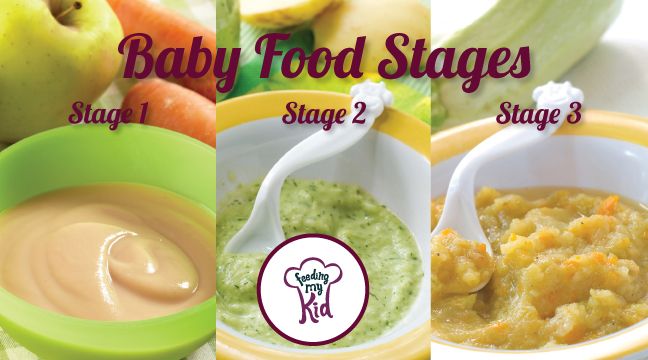 It’s important to continue exposing them to a wide variety of textures.
It’s important to continue exposing them to a wide variety of textures.
Safety Tips
- Always stay close to your baby.
- Make sure your baby is secured tightly in a highchair, sitting upright and not leaning back. Their feet need to be supported as well!
- Be sure to serve age-appropriate food size and texture.
- Avoid foods that are small and round (e.g. grapes, blueberries), hard (raw vegetables, nuts), or sticky (thick nut butter, candy) as they are choking hazards.
Is it going to be messy? Absolutely! As hard as it may be, learn to embrace it as it's SUCH an essential part of the self-feeding journey. In the meanwhile, here are some products that I recommend
What If your Baby Stops Eating
from my IG account: @kidfriendly.mealsBe Patient
It’s normal for your baby to resist texture at first because it’s unfamiliar and feels unsafe. While it's tempting to continue serving just purees, DON'T fall back! Keep marching forward otherwise your baby will never learn.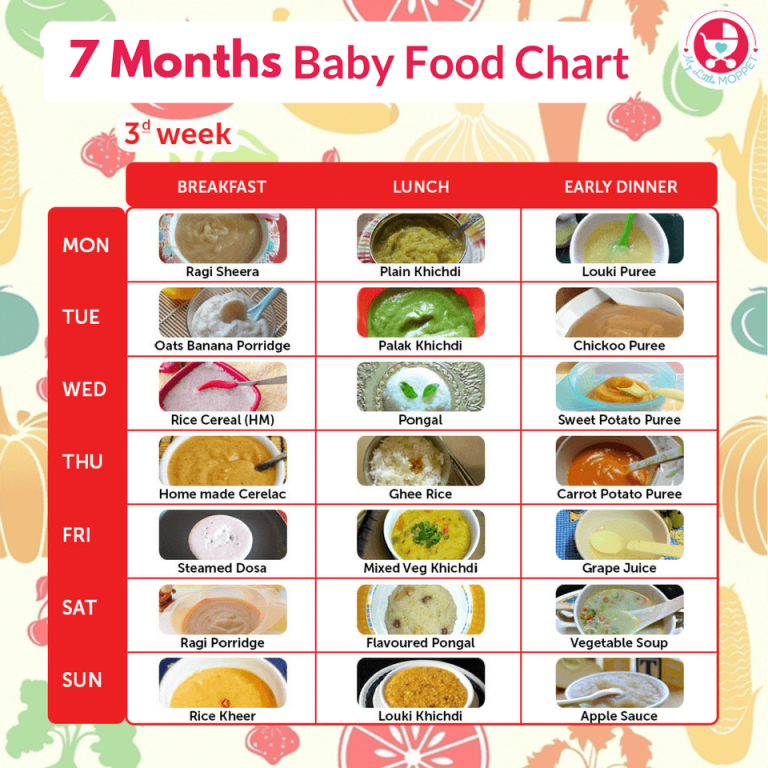
Of course you worry when your baby doesn't eat as much as you think they should, but by no means should you rush them or force-feed. You do need to gently and lovingly pressure/challenge them by continuing to offer.
Remember, learning to chew and swallow different textures takes time to master so keep giving them plenty of opportunities to practice in a safe, pleasant, and encouraging eating environment! That’s the best thing you can do!
Again, your baby is most likely not going to consume much, if any, at first. But remember, at this age, exploring all the different textures and advancing their oral motor skills (moving food around the mouth, chewing, etc.) is much more important than the amount of food that actually makes it into the belly.
With continuous exposure and practice, your baby will gain the skills and confidence needed to handle textured foods. And you'll be so glad that you stuck with it and didn't give in.
As you navigate through this challenging transitional period, I hope these reminders provide some much needed reassurance and peace of mind.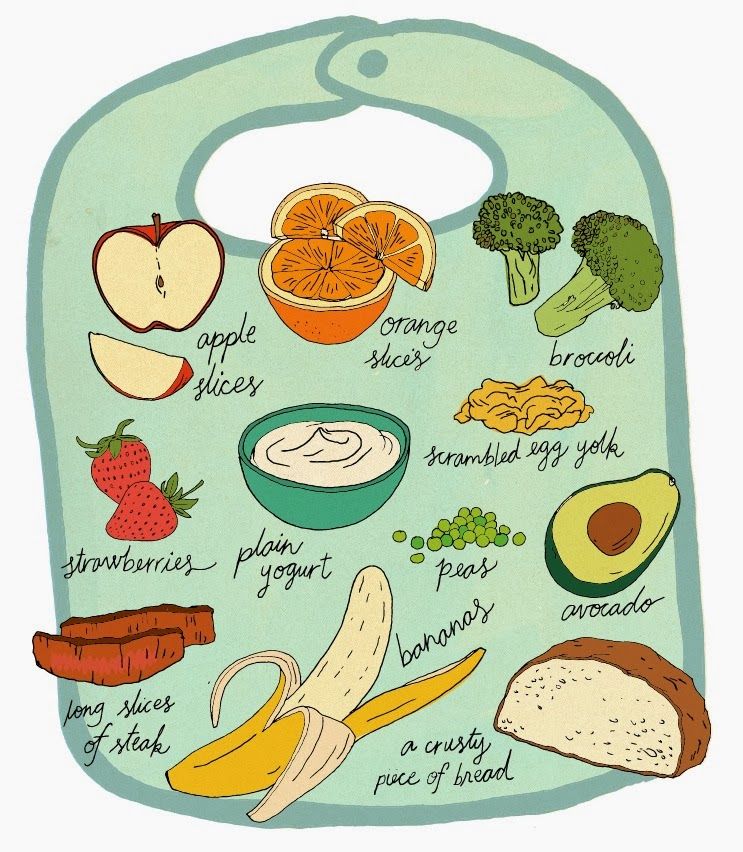
- Your baby’s appetite will vary from day to day.
- Their tummies are tiny so they don’t need much.
- Breastmilk/formula will continue to be the main source of nutrition during the 1st year. If your baby didn't eat much, you can offer milk about 30-45 minutes after the meal has ended (don't offer immediately after). That way they're still getting the nutrition they need, and they won't make the association of "ooh if I don't eat, mommy will give me milk!"
Gagging
Most likely, there will be a lot of gagging. This is again quite normal as your baby learns to handle new textures. It’s a safety mechanism that actually helps prevent choking and helps your baby in learning to manage food safely.
So don’t fall back on offering the safer purees. Again, gently challenge them to accept new textures and to learn to chew by offering a variety.
On the other hand, if the gagging persists and your baby is visibly upset then it’s best to consult with your physician to make sure there aren’t any other underlying issues, like oral motor delays, sensory sensitivity, or a medical condition, that need to be addressed.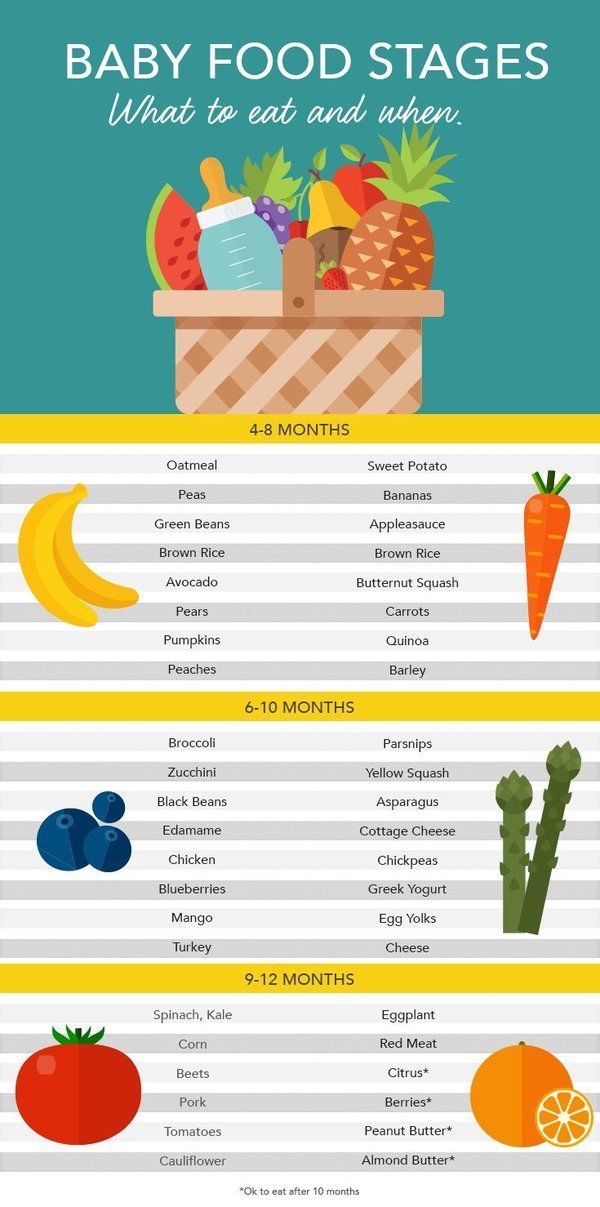
Spitting
As babies are learning to chew and swallow, they will likely spit out food that is too large to swallow. It's also a part of learning to chew. So don't intervene. Let it be.
Role Model!
It's important to keep the mealtime environment safe and positive. Offer different textured foods without pressure and encourage your baby's curiosity with exploring the food. The best thing you can do is have your baby join the family during mealtimes as much as possible. They learn so much from simply watching what you do. The more they see everyone enjoying their food, laughing, and having a grand ole time, the more they're going to want to be a part of it.
Show how you grab food with your hand and bring to your mouth. Exaggerate chewing with your mouth open. This is not the time to mind your table manners.
EACH and EVERY time your baby is exposed to new flavors and textures, they are learning and gaining confidence from it.
I want to leave you with this:
Be patient.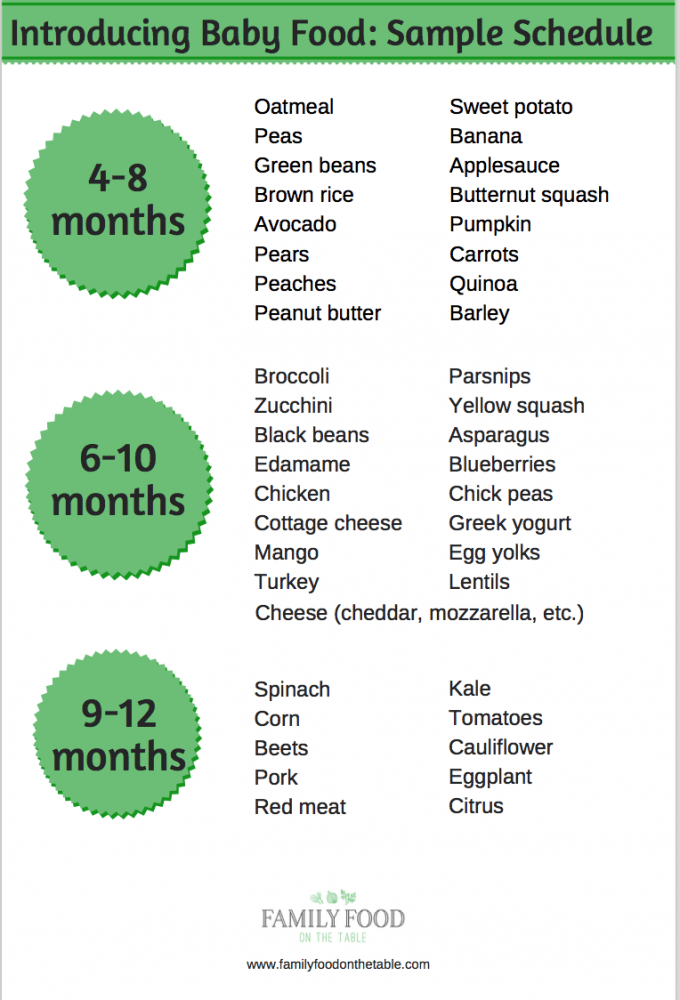 Continue to offer a wide variety of textures (and flavors!). Trust the process! It's one bumpy ride and we need to be in it for the long-haul. And if you need a step-by-step guidance, check out my 3 month program below. It's complete with daily cooking demos, game plan, recipes, etc. to help you to move beyond purees!
Continue to offer a wide variety of textures (and flavors!). Trust the process! It's one bumpy ride and we need to be in it for the long-haul. And if you need a step-by-step guidance, check out my 3 month program below. It's complete with daily cooking demos, game plan, recipes, etc. to help you to move beyond purees!
Do you want to minimize picky eating and set a solid foundation for a lifetime of healthy eating habits?
Check out this 3 month mastering self-feeding program! It’s the closest thing to me being in your kitchen
Introducing Solids: Foods & Textures
Read time: 8 minutes
What to know about starting your baby on solid foods:- Let your baby lead the way with food
- Learn your baby’s cues for hunger and fullness
- Offer a wide variety of flavors and textures
- Avoid certain foods in the first year
Starting solids is an exciting milestone and huge transition in your baby’s first year. When your baby seems ready (for most babies, at around six months), it’s important to let them lead the way with food.1
When your baby seems ready (for most babies, at around six months), it’s important to let them lead the way with food.1
Allow your little one to decide how much and even whether they want to eat.2 Keep in mind that erratic eating patterns are perfectly normal. Just like you, your baby may be very hungry one day and less hungry the next. By being mindful of your baby’s hunger and fullness cues, you’ll both learn together.3
Read more: Starting Solids: Signs of Readiness
Getting Started: How much should I feed my baby?Start by offering 1 to 2 tablespoon of food one to two times per day.6, 27 It is perfectly normal for your baby to push food out of their mouth while learning to handle solids.1
Remember, your initial goal is to introduce your baby to the new tastes and textures of solid foods. At first these foods will not contribute many calories.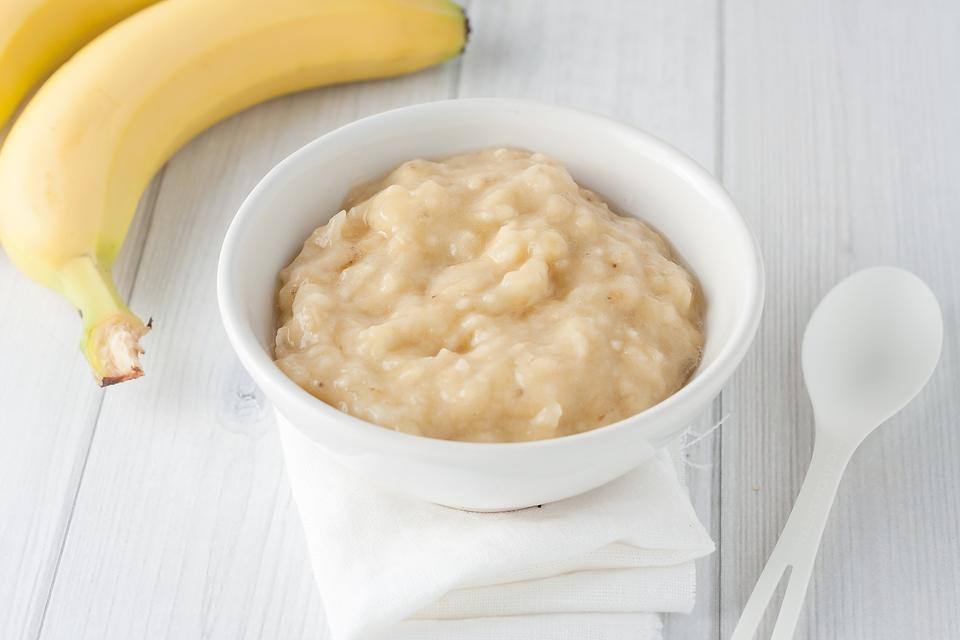 Rest assured, even if baby doesn’t do much eating, breastmilk or formula (or a combination) will continue to provide your little one with most of the nutrition they need for the first year of life.7, 8
Rest assured, even if baby doesn’t do much eating, breastmilk or formula (or a combination) will continue to provide your little one with most of the nutrition they need for the first year of life.7, 8
Single ingredient foods first
Introduce one “single-ingredient” food at a time from any food group and wait 2-3 days before introducing a new one.1 This would allow you to observe for any allergies or intolerances. During this time you can continue to offer all other foods that you know your little one can already tolerate.
Learn more: Starting Solids Food Chart
Gradually increase the variety and amount of food you feed your babyAs your little one gets the hang of eating and shows interest in eating more, you can begin offering foods 2 to 3 times per day.6, 27
Consistently exposing your child to a wide variety of healthy foods is key in expanding your baby’s palate.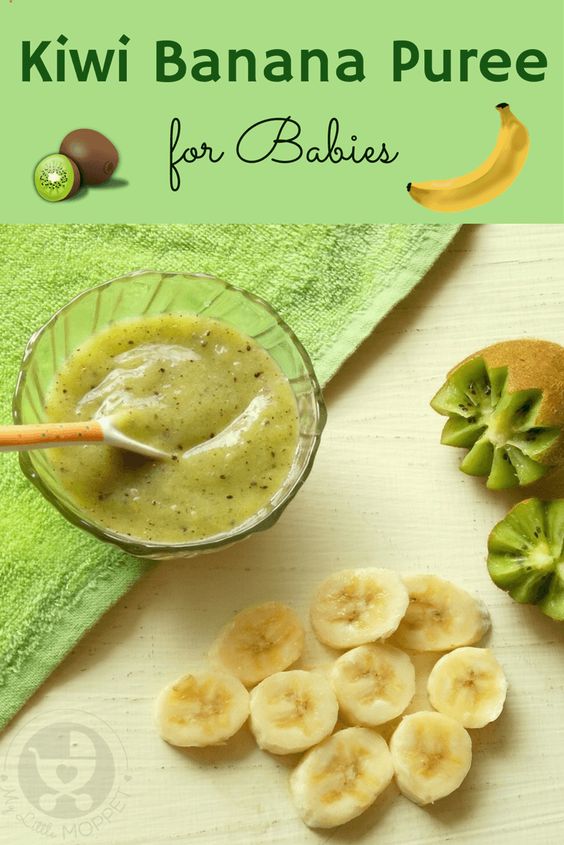 9 Focus on introducing lots of vegetables, fruits, proteins, and whole grains in the texture your baby can handle without worrying so much about the order of the introduction.10, 11
9 Focus on introducing lots of vegetables, fruits, proteins, and whole grains in the texture your baby can handle without worrying so much about the order of the introduction.10, 11
Babies do naturally like sweet tastes, so letting them experience the real and sometimes bitter taste of vegetables – repeatedly – can help your little one to accept these foods.12,13 If your baby doesn’t like something at first, don’t worry. It can sometimes take more than 10 tries for a child to accept and enjoy new or disliked foods and flavors, so stick with it!13, 14
Read more: Learning to Love Healthy Foods
Baby’s first foodsResearch shows that the first few months of solid food eating is the best window of opportunity to get a child to eat new, healthy foods.9,13 When first introducing foods to your little one, you may choose to cook and puree foods, or gently mash soft foods.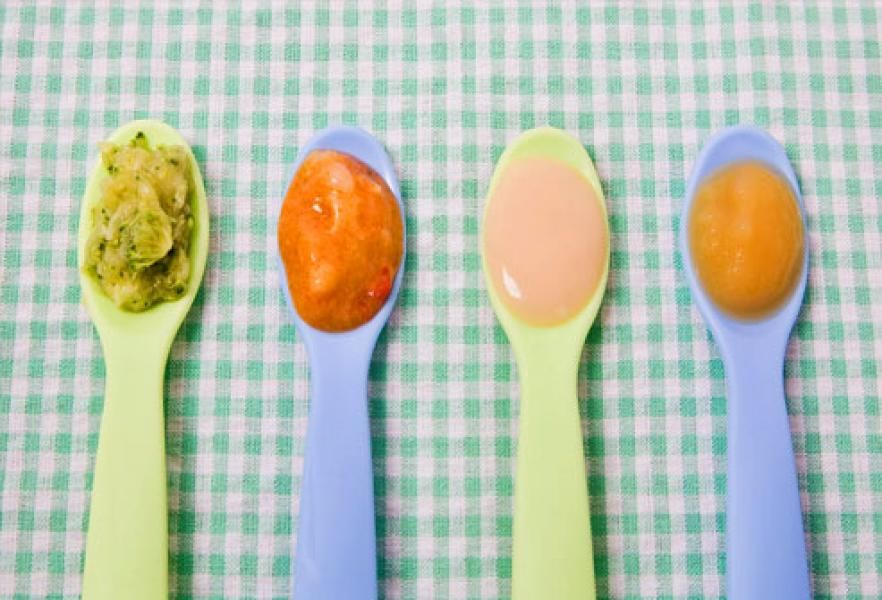 Prepared baby purees are also an option.
Prepared baby purees are also an option.
Here are some first foods to try with your baby:
- Peeled, soft cooked, pureed or mashed apple, pear, carrots, or butternut squash
- Mashed, peeled, ripe banana, avocado, pear, peaches, or kiwi
- Soft cooked (peeled when needed) pureed peas, broccoli, green beans, sweet potatoes, or white potatoes
- Pureed soft cooked proteins like fish, tofu, beans, chicken, turkey, or beef
- Pureed cereals such as rice, barley, oats, or quinoa
- Plain whole milk yogurt blended with fruit
Read more: Introducing Solids: Different Approaches and Strategies
Don’t delay: Advance food textures as soon as your baby is readyOnce your baby is eating more and doing well with purees, it’s important to advance to more solid textures. Research shows that waiting beyond nine or ten months to progress to lumpier foods may lead to selective eating and even rejection of food consistencies other than purees.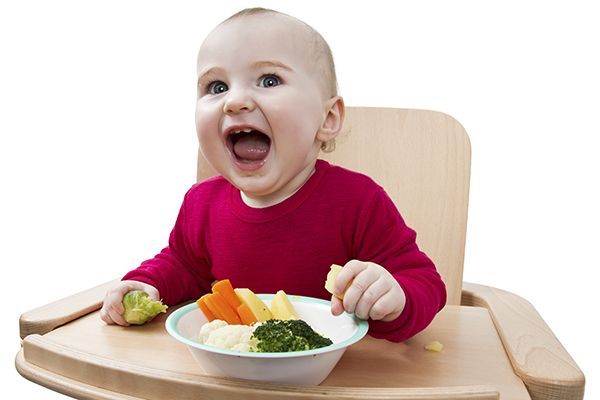 15,16, 17
15,16, 17
If you began feeding your baby purees, be sure to advance to a thicker, lumpier consistency once your baby is ready.
When your baby has mastered thick and lumpy purees, move on to soft finger foods.
Make sure that anything you feed your baby can be easily smushed between your fingers. This way you know your little one will be able to ‘gum’ their food, even if they do not have many or any teeth.15
By the end of your child’s first year they will most likely be able to sit at the family table and feed themself soft finger foods.18
Examples of foods with more texture include:
- Slivers or finely chopped pieces of soft cooked meat, like soup chicken or ground meat in a broth or mild sauce.
- Scrambled eggs
- Strings, pea-sized soft cubes, or small pieces of cheese
- Over-cooked whole grain pasta with some butter, olive oil, parmesan, or ricotta cheese
- Cooked whole grains, like barley, oats, or quinoa
- Cubes or strips of roasted or steamed vegetables: Sweet potato, squash, zucchini, green beans, and asparagus tips.

- Small chunks of soft avocado, banana, and over-ripe peaches.
- Whole-grain bread or waffle strips
Read more: Meal Plan for 6 to 9 Month Old Baby
Foods to AvoidCertain foods pose a health risk while others pose a choking risk.
Foods to avoid during the first year of life:
- Honey due to the risk of botulism spores20
- Whole milk due to the risk of iron deficiency and intestinal bleeding when given in large amounts during infancy.21 (Note that feeding your baby yogurt or using whole milk in recipes is perfectly safe as long as they do not have a milk protein allergy or lactose intolerance).
- Added sugar and salt (Do not add sugar or salt to foods).22
- Choking Hazards such as nuts, seeds, dried fruit, popcorn, whole grapes and cherry tomatoes, whole kernel corn, olives, hot dogs; hard, raw fruits or vegetables such as apples, celery and carrots; chunks of meat or poultry; hard candy, gum drops and jelly beans.
 23, 24
23, 24 - Caffeine-containing foods such as coffee, tea and cola drinks which can make babies and children irritable.25
- Fruit juice. Babies under 1 year should not have fruit juice.26 Children aged 1-3 years should have no more than 4 oz of 100% fruit juice (may be diluted with water) 26
Read more: Avoid Giving Your Baby Too Much Sugar and Salt
Learn about: Preventing Choking in Infants and Toddlers
Tips on how to get your baby started on solid foodsAllow your child to learn to eat by experimentationEven if this means playing with the food; throwing most (or all) of the food on the floor; tasting the food only to then spit it out; and even smearing the food in their hair – let your baby have fun with food! It’s messy but will help your little one learn to feed themselves as well as be more likely to taste a new food you’ve provided.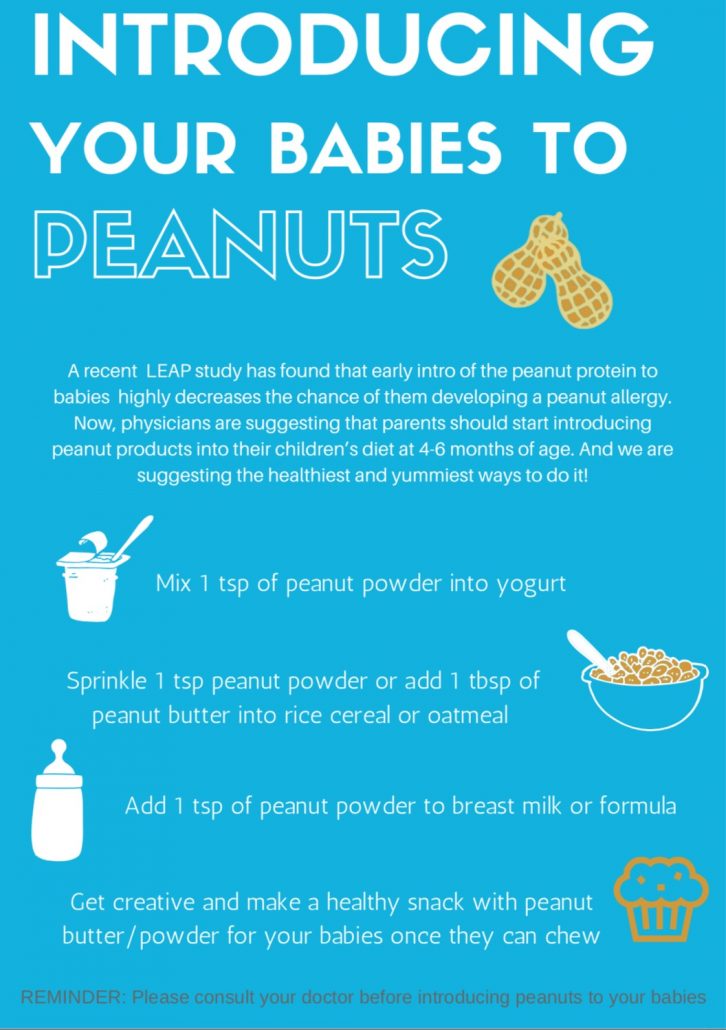 29
29
Read more: Teaching Your Baby to Self-Feed
Follow your baby’s hunger and fullness cuesHunger
Any new skill can be frustrating to learn, and eating solid foods is no different. To minimize the challenges, offer your child food when they are showing signs of hunger, but are not ravenous. 1, 4 , 5 A child that is too hungry may not have the patience to practice eating solids.
Your baby’s hunger cues:
- Smiling, gazing, and cooing at you during feeding
- Leaning their body or actively moving their head towards food
- Grabbing at the spoon or a hand holding food
- Attempting to swipe food toward their mouth
- Fussing and crying (provided, of course, you have ruled out other reasons like a full diaper or other discomfort). This is a late sign of hunger. Your little one may be too hungry at this point and may prefer breastmilk or formula over solids to fill their bellies quickly.
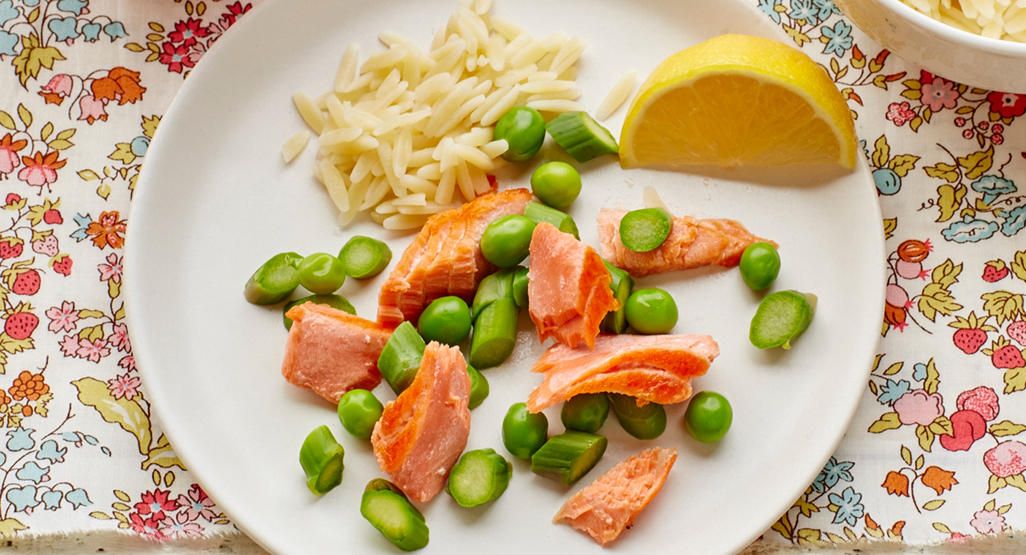 1, 4 , 5
1, 4 , 5
Fullness
It’s important to practice responsive feeding: Feeding your little one when they indicate hungry and stopping when they’re full. Let baby decide how much food they want to eat. Don’t try to get in one more bite!
This is the time your little one is learning to listen to their body and to stop eating when they are full. Forcing your little one to eat when they don’t want to may have unintended consequences, such as overriding your baby’s internal hunger and fullness cues or developing unhealthy eating habits.28, 19
Your baby’s fullness cues:
- Pursing their lips or closing their mouth
- Turning or moving their head away from the approaching spoon or a hand holding food
- Leaning their body away from the advancing spoon or hand with food
- Acting uninterested or wanting to avoid the food entirely
- Becoming easily distracted from the food in front of them
- Spitting out the food or stopping eating altogether
- Throwing food onto the ground or play with the food28, 19
Learn more: Understanding Your Baby’s Hunger and Fullness Cues
Start practicing the Division of ResponsibilityWhen it comes to feeding your little one, the Division of Responsibility (DOR) can help take the stress out of mealtime.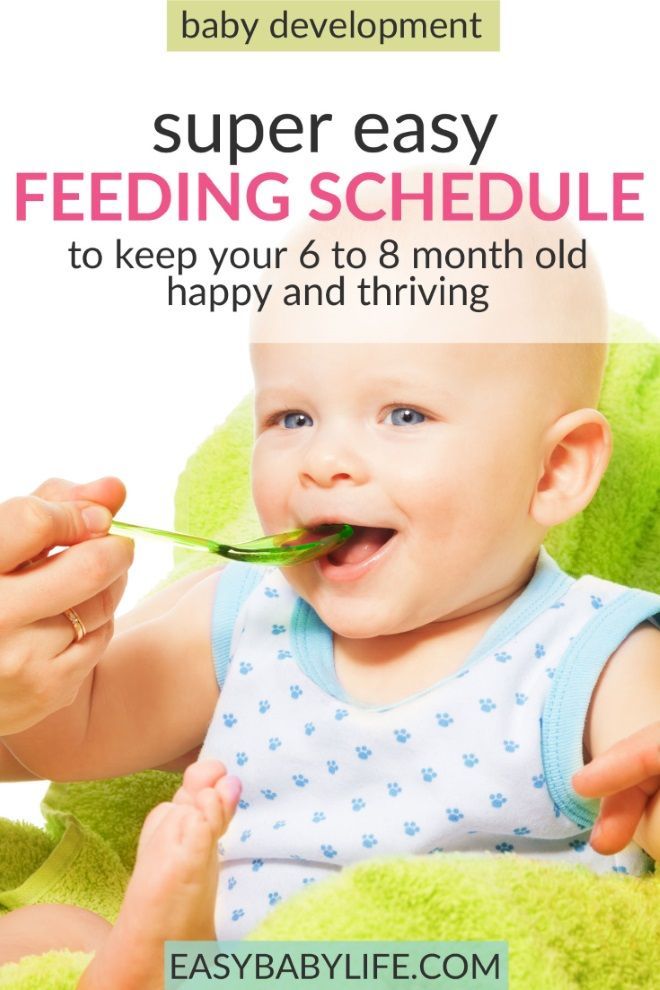
- Your job in the DOR is to provide healthy foods, at a table or highchair, and at specific meal and snack times.
- Your child’s job is to decide how much of each food to eat… and whether they will eat it at all.30
This strategy can be used beyond infancy into childhood to help keep peace at the table and help prevent picky eating.31
Read more: The Division of Responsibility: Helping Avoid Picky Eating
Let baby practice with utensils and cupsStart offering a small amount of water in a sippy cup or soft infant cup (only a few ounces per day total) to allow your little one to practice. This will help them build their fine motor skills as well as get them used to drinking water.32
Provide baby spoons and forks and let your little one have fun.33 At first it may be just something to play with, but eventually they will get the hang of it!
Include your baby in family mealsFrom the beginning, expose your baby to a variety of healthy food choices and appropriate mealtime behavior. 34 It’s never too early to start fostering a healthy relationship with food. Turn off the TV and any other distractions and allow everyone to focus on their food and each other.35
34 It’s never too early to start fostering a healthy relationship with food. Turn off the TV and any other distractions and allow everyone to focus on their food and each other.35
Read more: Family Meals: Healthy Eating Patterns
Let’s Chat!We know parenting often means sleepless nights, stressful days, and countless questions and confusion, and we want to support you in your feeding journey and beyond.
Our Happy Baby Experts are a team of lactation consultants and registered dietitians certified in infant and maternal nutrition – and they’re all moms, too, which means they’ve been there and seen that. They’re here to help on our free, live chat platform Monday through Friday, from 8am–6pm ET, and Saturday and Sunday, from 8am–2pm ET. Chat Now!
Read more about the experts that help write our content!
For more on this topic, check out the following articles:
Introducing Solids: Signs of Readiness
Introducing Solids: Different Approaches and Strategies
Preventing Choking
How Can I make my own Pureed Baby Food?
How to avoid giving your baby and toddler too much sugar and too much salt
Introducing Major Food Allergens
Family Meals: Healthy Eating Patterns
Solid food, a detailed guide to the introduction of solid food in infants
solid food For babies, this is a must when the baby is six months old, as every parent craves to see their baby's first meal.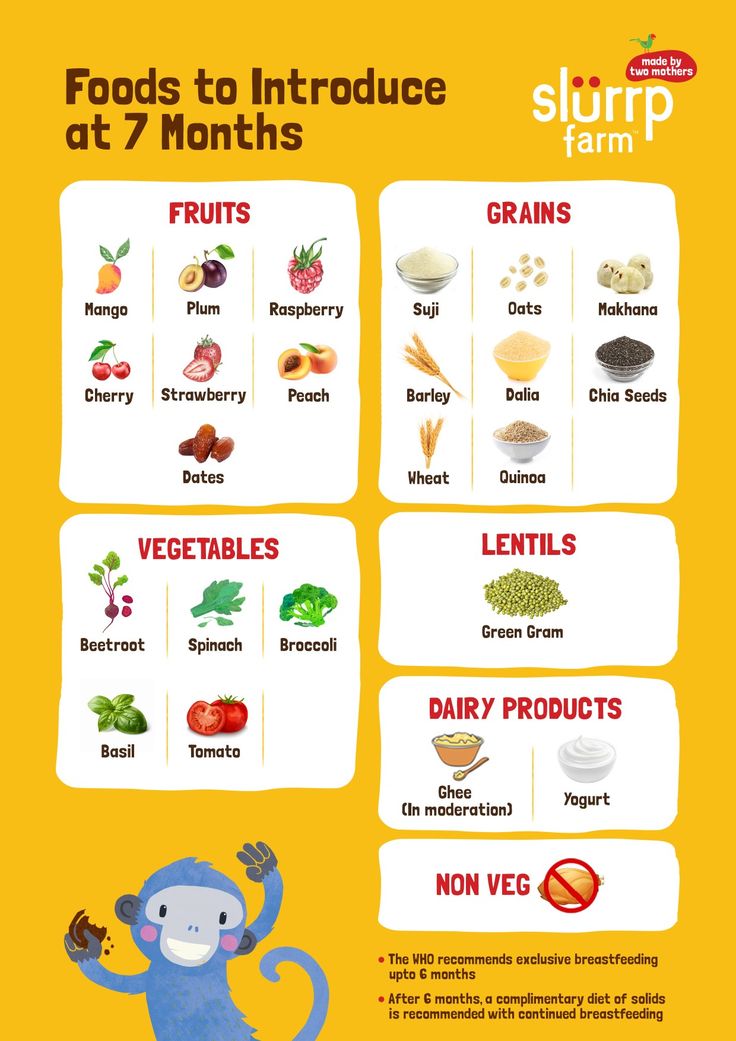 If we are well prepared, the process of learning about food can be a magical moment between our child and us. While there is a lot of information out there, the only person who will guide you through this adventure is your child. They will pave the way, and you will follow them.
If we are well prepared, the process of learning about food can be a magical moment between our child and us. While there is a lot of information out there, the only person who will guide you through this adventure is your child. They will pave the way, and you will follow them.
You need: Scoliosis in children and treatment
In this article
When is the right time to introduce solid foods?
We've put together all the information you need to help you understand and get you started on solid foods without stress or pleasure. You should wait until about four to six months before introducing solid food into your baby's diet, and until then breastfeed only or use infant formula.
While some infants show early signs of readiness, it has been shown that introducing solid food to an infant before the fourth month of life poses a risk of particles entering the respiratory tract causing aspiration.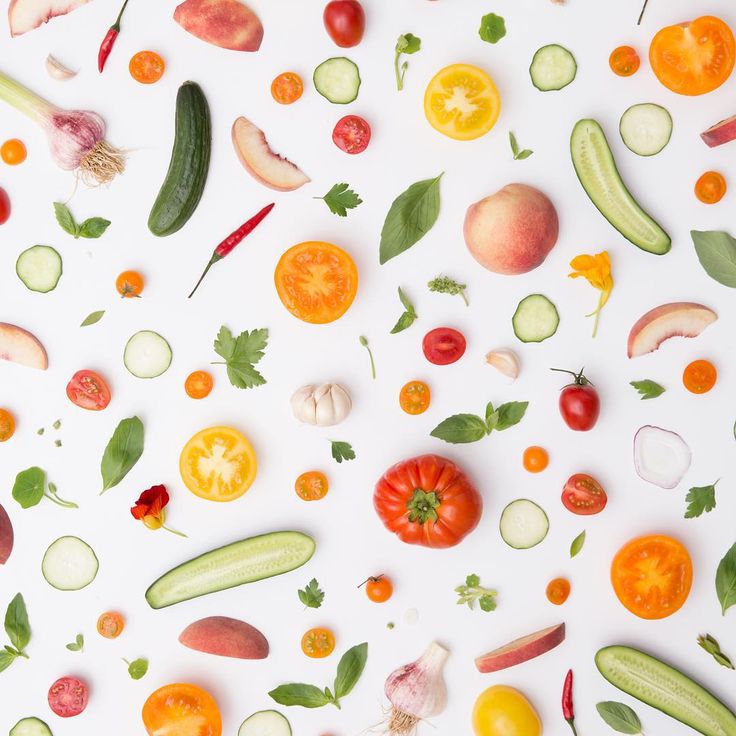 It can also increase the risk of obesity and prevent a child from getting the right amount of nutrients and calories. But deciding when to start is a delicate balance. You don't want to start early, but you shouldn't start too late.
It can also increase the risk of obesity and prevent a child from getting the right amount of nutrients and calories. But deciding when to start is a delicate balance. You don't want to start early, but you shouldn't start too late.
Studies have shown that delayed onset can lead to iron deficiency, delayed mouth movement, and stunted growth in the child. The wisest thing to do to avoid stress and anxiety is to wait until the sixth month and look for signs that the baby has developed enough to switch to another meal plan.
You need: Is crying good for a baby?
Signs that the baby is ready for solid foods
Around six months of age, the baby begins to show signs of being ready for solid foods. Here are some signs to look out for:
sitting: Your child should be able to sit up straight with a little support.
Increased neck control: This is the key to preventing choking.
Contractile reflex and tongue thrust: It is no longer necessary to push food out of the mouth when it is offered, which means that the child is learning to control the tongue-pulling reflex.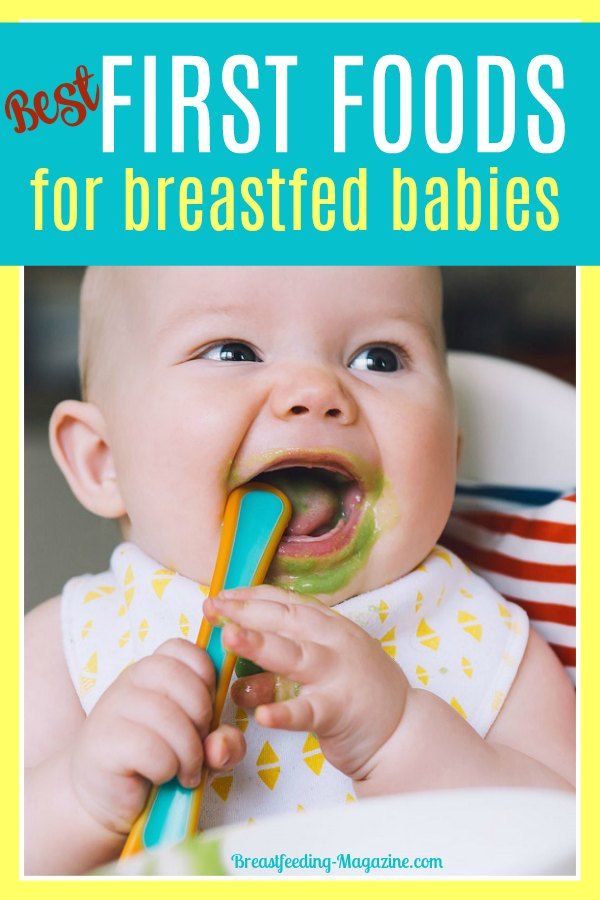
Responsive lips: Your child closes his lips around the spoon and holds it in his mouth.
Attention to food: They try to take a piece of food and bring it to their mouth when you give it to them.
There are many myths about signs of readiness that can cause headaches in nulliparous mothers. Here's the truth: Just because a child watches you eat, it doesn't mean he's ready to eat solid food. We are simply the child's closest relation to the human experience, and he has no choice but to be amazed at everything we do.
Tip, do not consider your child's weight when making a decision. Your child's average weight and size may be smaller or larger than usual. These anomalies do not automatically mean that he needs solids if he is smaller, or that he is ready for it if he is larger.
What you need: Measles, what you need to know
Which solid foods should a child start first?
Although there is no set order, the most natural strategy is to start with liquid food or pureed food. You will then move on to more carefully curated options and eventually introduce them to solid foods.
You will then move on to more carefully curated options and eventually introduce them to solid foods.
Once the child is in the mood to explore and all the basic signs have been checked, you are both ready to begin your exploration. To avoid damaging your child's gums, choose bananas, peaches, sweet potatoes, carrots, and boneless meats as the base. Anything soft will do.
All finished products - most of them at this stage - should be tender. Keep it simple There is no need to season baby food - it can irritate the stomach.
Solid food, a detailed guide to introducing solid food into a child's dietWheat-based food should contain only one ingredient and should always be mixed with water, breast milk or formula. Start with small amounts of only one type of food, and as you follow their signals, increase the amount. Just make sure you keep an eye on them at all times as there is still a chance of choking at this age.
What you need: Infant Constipation - Treatment, Prevention and Home Remedies
Start solid foods in a month
Family meals and quiet hours are great places to start. You can also use this moment as an opportunity to begin the ritual of washing your child's hands before placing them in the high chair.
You can also use this moment as an opportunity to begin the ritual of washing your child's hands before placing them in the high chair.
It may seem like a lot if your daily menu includes foods rich in iron, as well as colorful fruits and vegetables. You will also be serving meat and moving from mashed to textured food at the right moment. However, this shouldn't be difficult.
Offer solid food allergens
You might think that avoiding foods such as peanuts, fish, wheat, eggs, and soybeans is a good idea when introducing solid foods to a child because of their general allergenic nature.
Studies show that including these foods in a child's diet, especially between 4 and 6 months of age, may be helpful in preventing any food allergy of this type. The trick is to reduce the amount of food in the child's diet (while trying not to attack his immune defenses), doing it gradually. Traditional available foods should be introduced first (eg, cereals, meats, mashed vegetables and fruits), and then, after the child's reaction, include one or two foods that cause allergies.
Be safe Talk to your child's doctor before introducing foods that can cause allergies, especially if you have a history of allergies in your family. Although some children require some safety precautions when it comes to potential allergies, there are many products specifically designed to introduce an allergen into a child's immune system.
What you need to know: What you need to know about constipation in babies
The following are signs of possible allergic reactions to solid foods.
- The child has a close relative with a food allergy (a brother who is allergic to peanuts).
- any levels of eczema (moderate to severe) persist after treatment.
- Which food allergy was previously identified in the child - or a positive Sensitivity test result.
Signs of food allergy due to the introduction of solid food
Most allergies are usually recognized during this period of development. As a rule, children are allergic to the same food groups as their parents. Or they may develop allergies that their parents don't. In infants, symptoms appear shortly after eating, and the foods most commonly associated with allergic reactions are milk, eggs, and peanuts.
Or they may develop allergies that their parents don't. In infants, symptoms appear shortly after eating, and the foods most commonly associated with allergic reactions are milk, eggs, and peanuts.
The most common signs of a solid food allergy to look out for are:
- swelling of the lips or tongue or face.
- Vomiting أو diarrhea.
- shortness of breath.
- cough and wheezing.
- urticaria or bruises.
- Skin rash.
- The child begins to rub his mouth.
Pay attention to allergic reactions. If swelling, severe vomiting, or difficulty breathing after eating, in less severe cases such as a rash or redness, tell your GP or your child's pediatrician.
What you need: Sore throats in children, causes, symptoms, prevention and treatment
Breastfeeding solid food balance
Contrary to what it may seem, introducing solids does not have to be synonymous with the end. Breast-feeding.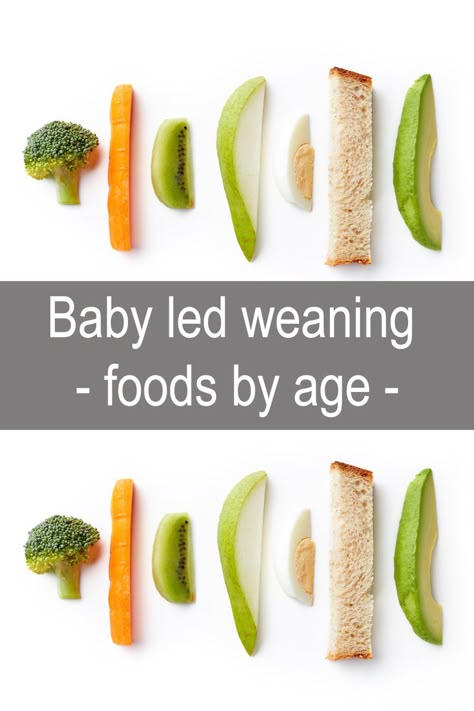 The gradual inclusion of food intake is part of the development of the child's maturity and is necessary to increase his independence. The gradual introduction of solid foods is especially beneficial for both the parent and the child - meaning that given how independent the child is, it also means less need for constant care.
The gradual inclusion of food intake is part of the development of the child's maturity and is necessary to increase his independence. The gradual introduction of solid foods is especially beneficial for both the parent and the child - meaning that given how independent the child is, it also means less need for constant care.
During the first six months of a baby's life, breastfeeding is recommended as the only source of nutrition. The same goes for the next six months with the gradual addition of solids.
Iron-fortified solid foods and cereals go well with breast milk, but the following information can help you with this process:
من 0 لى 4 ر
Stick to only milk or formula. You can expect your child to drink 2 to 4 ounces and you will feed him whenever he is hungry.
من 4 لى 6 ر
You are still on breast milk or formula. Your baby will need 6 to 10 feedings a day and will likely need 3 to 6 ounces per feeding.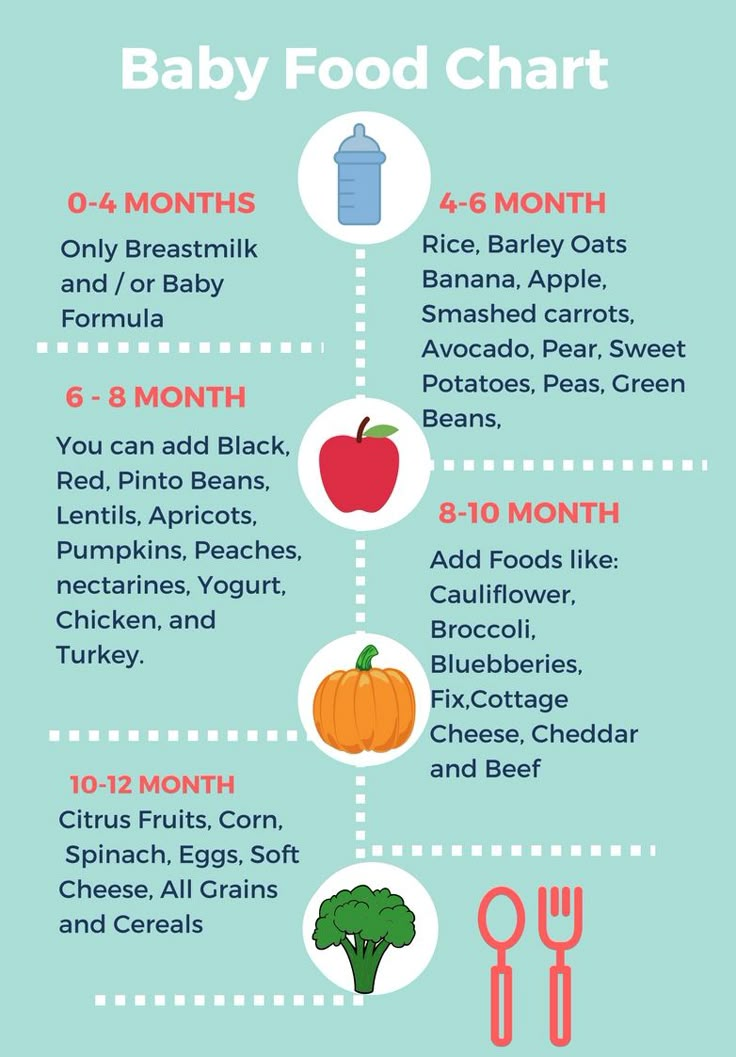
6 to 7 months
Most recommendations say that you don't need to eat solid food every day at first, so repeat it "every few days." Continue breastmilk or formula - 5 to 9feedings per day at 4-6 ounces per feeding.
من 7 لى 9 ر
Solid food should be added daily according to the child's interest. The recommended maximum of two meals per day is the recommended amount, and if a parent is considering adding juice, it is best to dilute it with water and no more than three to four ounces per day. Breast milk or formula should be given 5 to 8 times a day, usually 4 to 6 ounces each time.
9 to 12 months
Solid foods should increase and children should start feeding themselves solid foods. By their first birthday, they should be ready to start drinking cow's milk, expecting 4 to 6 breast milk or formula feeds per day at 4-8 ounces per feed.
What you need: Children's sleep needs - the right amount of hours per night for your child
Other Solid Food Tips for Babies
When you begin your solid body journey, things can get confusing—literally.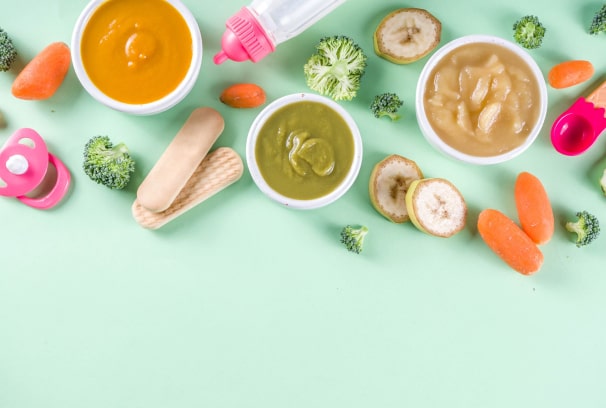 That's why spoon-feeding your baby will not only cut down on cleaning time, but it will also help your child learn how he'll eat when he's older. For more attention, you can give the child another spoon so that he holds it in his other hand. Putting a spoonful of each first solid food in your baby's mouth can be a magical experience. Start by introducing solid foods at one meal a day, and then gradually increase the amount.
That's why spoon-feeding your baby will not only cut down on cleaning time, but it will also help your child learn how he'll eat when he's older. For more attention, you can give the child another spoon so that he holds it in his other hand. Putting a spoonful of each first solid food in your baby's mouth can be a magical experience. Start by introducing solid foods at one meal a day, and then gradually increase the amount.
Morning is a good time to start as your child is often hungry. Even though your child is old enough to keep his head and neck still, there is some risk of choking.
To avoid choking on solids, keep these tips in mind:
Avoid Bottled Solids: Do not give your baby oatmeal or bottled solids.
soft safe: Always make sure that food is soft, cut into small pieces and easy to swallow.
Avoid unsafe foods: Avoid giving children nuts, popcorn, candy, and solid foods that you cannot safely serve.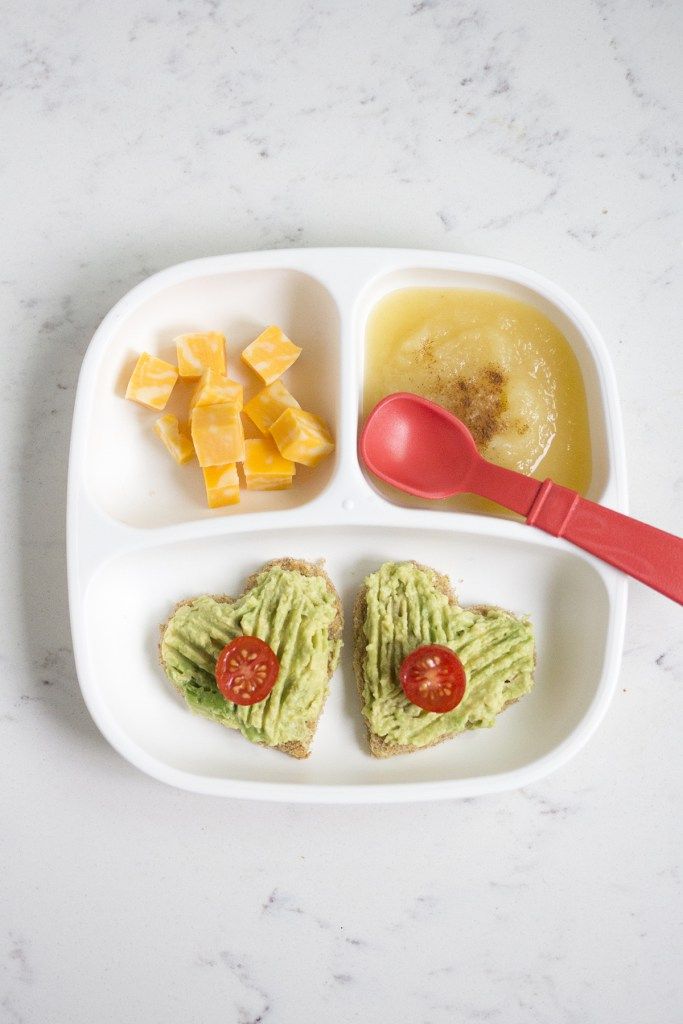
Keeping the child stable: Sit the child upright in the seat and fasten the seat belt to keep the child stable.
Reacting to what's in the spoon or just completely ignoring it is normal, the transition from exclusively breast milk or formula to a diet based on solid foods is a long process. It's also a great new stage for your baby.
New and different products are needed every month, so it's a good idea to refer to this guide as it gets exciting. And remember, once upon a time you were a small child and you didn't have teeth to help you. Be patient and calm, knowing that in due time your child will become a big eater.
Source : Introduction of complementary foods for a child
How to teach a child to chew - Encyclopedia Baby food
Levchuk Victoria © How to teach a child to chew is a very important question that parents ask. We think that chewing is a natural skill that is easy to learn, but for a baby it is not so easy. Therefore, let's look at what chewing is, how to learn it, what to do if the baby has not learned to chew, etc.
Therefore, let's look at what chewing is, how to learn it, what to do if the baby has not learned to chew, etc.
Table of Contents:
Chewing - crushing pieces of food with the teeth by repeated closing and opening of the jaws to soften and break it up with saliva before swallowing.
There are many different reasons why parents should worry about their child and start doing something. These can range from problems in oral motor development, eating difficulties, swallowing problems, dependence on enteral nutrition, and weight loss. One of the most common reasons for seeing a GP is that a child has difficulty switching to solid foods or chewing .
Parents also tend to panic for no reason. Here I propose to read the article and really evaluate the child's ability to chew. You can go to your pediatrician or consult with a speech therapist. As usual, we observe the "golden mean".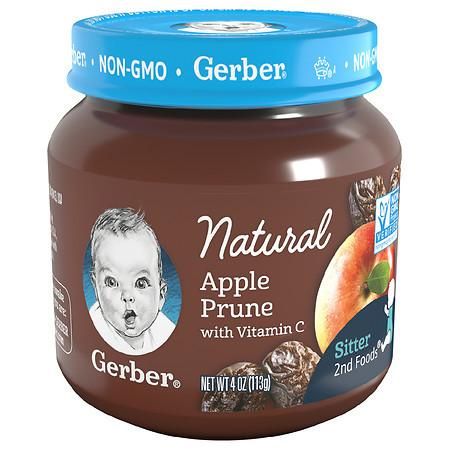 It is important not to panic and reduce the problem with chewing, but to realistically assess the child's skills.
It is important not to panic and reduce the problem with chewing, but to realistically assess the child's skills.
What does bad chewing look like?
A child who has difficulty chewing may have the following eating behaviors:
- Rapid swallowing of food, choking or vomiting due to any consistency, especially pieces.
- Child holds food in mouth, often behind cheeks. Some children will keep solid food for several hours.
- Sucking on solid food instead of biting and chewing. Often these children eat for a very long time. This way of feeding can lead to poor weight gain.
- Swallow food whole, which may cause choking or difficulty swallowing.
- Spitting out or "removing" solid food from the mouth.
- Avoid solid foods in favor of liquids and easy-to-handle foods such as purees or soft solids that the child can rub with the tongue.
- Bad eating due to difficulty in handling food.

For a child to eat properly, the texture or texture of the food on their plate must match their oral motor skills. If a child who cannot chew is given solid food, they have three options. The baby may suck on food, spit out food, and/or swallow it whole. All of these options have obvious negative consequences.
Chewing
Chewing is a complex motor pattern and skill that normally takes two years or more for a child to transition from sucking liquids and purees to chewing solids by mouth. Oral motor development often occurs in conjunction with major motor milestones, so it is essential to develop chewing skills in children from birth to three years of age.
How long does it take for a child to learn to chew solid food? This depends on several factors including readiness, the child's age, general motor function, gastrointestinal tract and sensitivity, muscle tone and motor control, readiness and craving for solid foods, and, last but not least, practice . All of these factors can influence the transition from sucking to chewing. Let's deal with them.
All of these factors can influence the transition from sucking to chewing. Let's deal with them.
Ready to Chew
Ready - Most children who cannot chew consume liquids, purees and struggle with their solids. It is necessary to determine whether the child is ready to learn to chew or work on chewing. There are certain factors that may influence this decision. If the child is unable to thrive or is underweight, then it may be more beneficial to improve the child's health and work on weight gain by ingesting more calories through liquids and purees before beginning to teach the child to chew.
Also, if the child receives his food through the tube , then you need to start learning with a light texture. In this case, simple textures such as purees and liquids should be accepted before moving on to chewing solid foods with a child who is still feeding orally. Some children naturally transition to chewing and solids with the practice of oral feeding.
Child's age suitable for chewing
Child's age - In normal development, infants begin experimenting with soluble solids around 7-8 months of age. This is where chewing is first seen by parents, and with practice during the first year of life, this develops into a vertical chewing pattern (lateral bite, jaw misalignment, still some sucking).
The mouth of baby at 7-8 months is still small, and due to lack of motor coordination, he usually receives only one piece of solid at a time, which allows oral practice in chewing, sucking and moving it.
When a child aged 2-5 learns this same skill, they have to deal with a much larger oral cavity that requires better tongue movement and oral control to prevent choking. Babies also have better fine motor skills and when large pieces are placed in the mouth, the size of the mouth makes them difficult to manipulate. The older the child begins to learn to chew, the more difficult it is to learn.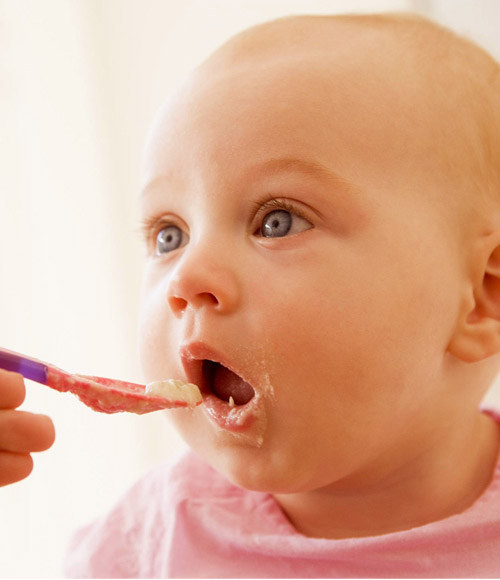 It must be understood that with an adult child will take more time to teach him how to chew solid foods.
It must be understood that with an adult child will take more time to teach him how to chew solid foods.
Since we are talking about age, let's look at how chewing naturally develops in young children.
Normal chewing development
0-7 months. Infants mainly use a sucking pattern for the first 6-7 months of life, sucking at the breast or bottle, and then ingesting a smooth consistency of baby purees via spoon feeding. Most babies begin spoon feeding after the baby has mastered some independent sitting skills. When a child first takes mashed potatoes from a spoon, he uses a sucking pattern or, to use medical terms, a “midline” tongue pattern, which means that the tongue is in the middle of the mouth.
7-8 months: at during this period, parents begin to offer solid foods (complementary foods) that dissolve or melt easily in the mouth. The child will practice moving the dissolving food along the sides of the mouth onto the gums with the mouth open, trying to "nibble" and then suck with the mouth closed.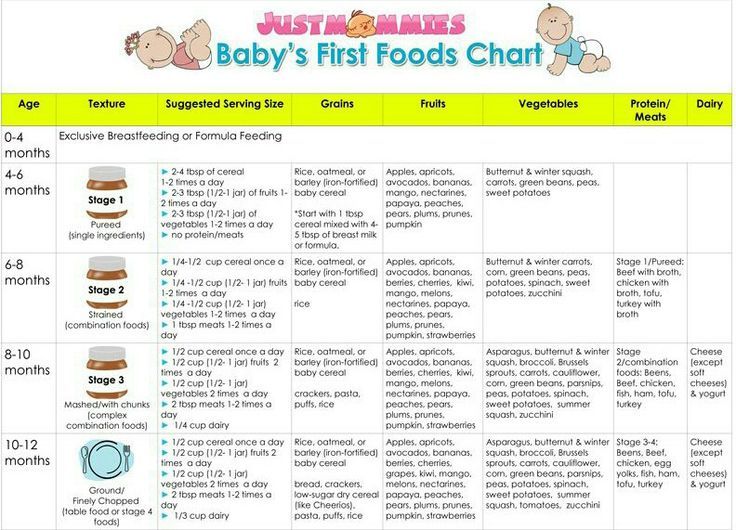 Swallowing during this phase is common. Vomiting is rare in this period, but may be indicative of some hypersensitivity. The baby will continue to use the suck/chew pattern for a few more months to learn how to move hard pieces to the side for biting and open-mouth manipulation.
Swallowing during this phase is common. Vomiting is rare in this period, but may be indicative of some hypersensitivity. The baby will continue to use the suck/chew pattern for a few more months to learn how to move hard pieces to the side for biting and open-mouth manipulation.
8–9 months: During this period, the child shows improvement in chewing skills with soluble solid food pieces, parents begin to offer soft solid foods that can also be rubbed with the tongue. Many babies start crawling at this point. The child moves into a vertical chewing pattern that includes more tongue movement with lateral transfer of solids to the gums/teeth, open mouth bite, some jaw shifting, and then sucking. New chewers move from sucking to chewing over the course of several months, developing their skills.
1 year: Many children take their first steps around one year of age. At the same time, parents observe how most children begin chewing. After one year, most children can handle a variety of diced solid foods using a vertical, open-mouth chewing pattern. At this stage, they have more stamina and develop the skills to eat solid food and chew more during meals. Many babies still receive baby food and formula or breast milk.
At this stage, they have more stamina and develop the skills to eat solid food and chew more during meals. Many babies still receive baby food and formula or breast milk.
2-3 years: At two to three years of age, children transition from a vertical chewing pattern to an adult chewing pattern, with rotational or semi-circular jaw movement and improved language skills to move food in the mouth. It takes years for a child to practice and develop motor skills to master the muscles of the mouth and build the endurance for mature chewing.
Food consistency up to a year. Click on me!!!
Another table with food consistency is here.
Gross motor function
In typical development, many of the major motor milestones precede the development of oral language skills. Before a child starts to eat puree from a spoon and then eat pieces of food, he needs to acquire independent body stability, in a sitting position, rotation of the body and crawling.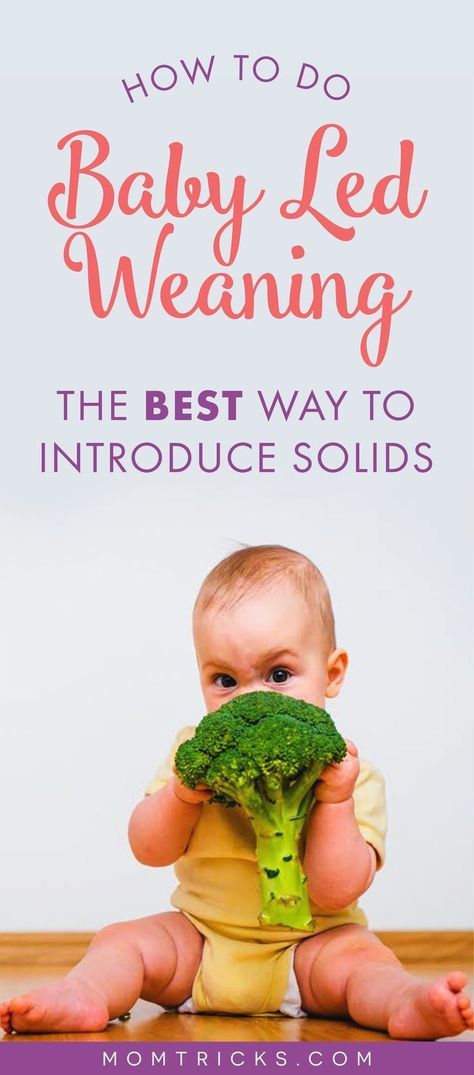 This postural control (regulation of body position in space) and patterns of body rotation maintain the stability required by the head, neck, and oral cavity.
This postural control (regulation of body position in space) and patterns of body rotation maintain the stability required by the head, neck, and oral cavity.
How does the GI tract and sensitivity affect chewing?
If the child exhibits oral hypersensitivity such as choking, gagging or vomiting pieces of food, it will be difficult to encourage eating and practice chewing due to negative and unpleasant experiences. This may well be the reason why the child does not transition to food pieces or finger foods during normal development. Some children choke / choke because they swallow the food whole, and when the parents return the baby puree, the choking stops. The child's general condition may also improve because he handles pureed foods well.
Some children are very sensitive / hypersensitive and may vomit food on the lips, tongue or cheeks. This is more than a psychological moment, because some children start gagging or vomiting at the sight of food.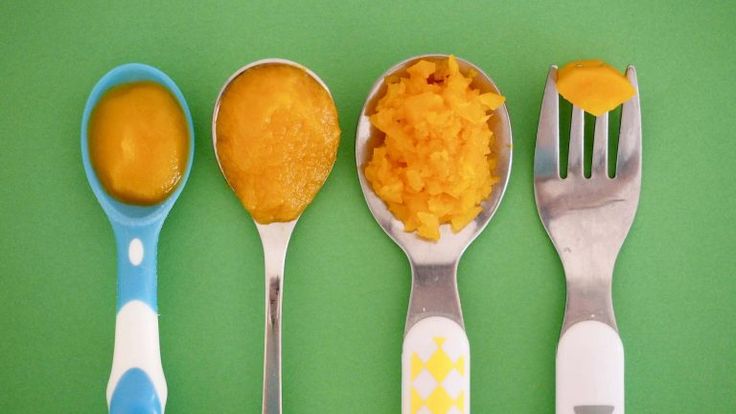 There are various recommendations from therapeutic practice on how best to deal with this type of problem. Some therapists start a desensitizing approach in the mouth.
There are various recommendations from therapeutic practice on how best to deal with this type of problem. Some therapists start a desensitizing approach in the mouth.
Others prefer treat it medically and nutritionally . Improvements have been seen in children using various types of medications for reflux, motility, pain, nausea, and constipation, as well as changing formula and/or slowing down tube feeding. The goal is to improve overall gastrointestinal comfort, which will result in the elimination of gagging and vomiting, allowing the child to transition comfortably to food pieces or finger foods.
A part of chewing training that includes jaw stabilization and movement of the tongue in a motor pattern. If a child has hypotonia or low tone, it may be more difficult for the child to stabilize the oral structures and have the strength for a consistent bite. It may be necessary to add a jaw support or base to stabilize the tongue (pressure under the jaw on the lingual muscle), to help child achieve a stronger bite with less fatigue.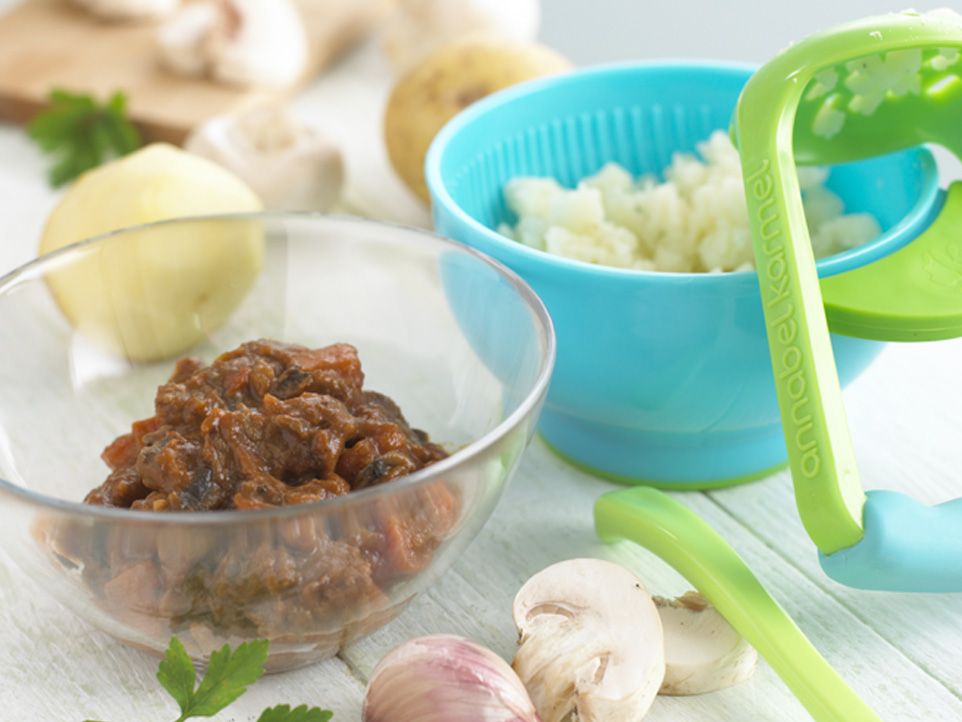 Building jaw strength through exercise takes time.
Building jaw strength through exercise takes time.
Willingness and desire for pieces of food
It is easier to progress and practice when the child is passionate about chewing and wants to participate in the process. However, many children get nervous or anxious when solid food is put in their mouth. Therefore, part of the process of learning to chew may include encouraging the child and creating a comfortable environment. This may include play activities such as feeding dolls. It may also include breaking up solids into crumbs and tasting, licking, and the practice of moving solids on the tongue.
Practice
Last but not least, the need for consistent daily practice. Chewing is a skill that needs to be practiced. Children should practice chewing components including lateral tongue movement, lateral movement and bolus recovery, bite force, and consistent bite. Therefore, it is necessary to find the best way to have several short training sessions throughout the day to help the child progress in chewing. This can be problematic as it is difficult for young children to do the same activities every day, which is why learning through play is so important.
This can be problematic as it is difficult for young children to do the same activities every day, which is why learning through play is so important.
At first, the child chews food with his mouth open . Children who are learning to chew always chew with their mouths open. If the baby is given finger food, and he closes his mouth, then most likely he sucks or sucks food with his tongue and palate. Children are taught to close their mouths while chewing, usually by the age of four or older.
Teaching a child to chew solid food - slow process . It is difficult to say how long it will take a child to acquire this skill, but approximately it will take at least 6 months if the child begins to suckle, is ready to study regularly and practices.
When a child can start chewing food
Babies constantly chew something, sometimes hands, sometimes toys, this is normal. Before introducing thicker purees, soft lumpy foods and easily soluble solid foods, make sure that the child is stable on his own and is approximately 8-9 months old. Infants must have physical and neurological maturity to excel in chewing. Not all children are ready for this at the age of 8-9 months. Many pediatricians say that switching to finger food is possible between 8 and 10 months. And only parents, looking at their child, decide whether he is ready to taste food in pieces.
Infants must have physical and neurological maturity to excel in chewing. Not all children are ready for this at the age of 8-9 months. Many pediatricians say that switching to finger food is possible between 8 and 10 months. And only parents, looking at their child, decide whether he is ready to taste food in pieces.
Can children chew food without teeth?
Children do not need to have teeth to learn to chew. The first steps of chewing require only movements of the tongue, jaw and cheeks. Due to the fact that the child receives only soft textures at first, healthy gums are able to cope with light chewing activity. Closer to 1.5 years, when molars begin to grow, the texture of food will already be complex fibrous, which is easier to destroy with teeth. While there are few teeth in the mouth, the child learns to chew and prepares the maxillofacial apparatus for more complex solid foods .
Chewing is a problem for some children
It takes a long time for a child to master chewing, and each child has a different learning path. From time to time, some children have trouble chewing solid foods, which is primarily due to the following reasons.
From time to time, some children have trouble chewing solid foods, which is primarily due to the following reasons.
1. Lack of food interest
Some babies lose food interest, especially when the same foods are introduced into complementary foods. Foods of the same texture are easy to chew, and this leads to a loss of nutritional interest. That is why it is so important to offer your baby different types of foods that differ in smell, texture and taste so that the baby can experiment.
2. Lack of finger foods in the early stages
The later a child gets to know finger foods, the more difficult it is for him to learn to chew solid foods. If the baby is only on breast milk for the first year, then it will be more difficult for him to learn to chew food and give up the habit of sucking.
3. Delayed introduction of complementary foods
Chewing is a pattern and skill that needs to be developed quite early. If parents choose to introduce complementary foods late, the child may have difficulty eating solid foods, and the child may prefer liquid foods such as baby puree.
If parents choose to introduce complementary foods late, the child may have difficulty eating solid foods, and the child may prefer liquid foods such as baby puree.
Here are some tips on how to teach your child to chew, especially if the baby is just learning.
1. Keep calm
To teach a child to chew, you need to maintain an atmosphere of peace and tranquility in the family at the common table. It becomes much more difficult to acquire the skill of chewing if the child's mood is bad. Stress negatively affects a child's appetite and prevents him from trying to chew his food.
2. Choosing the right foods
It is important to choose the right foods to introduce your child to finger foods. Products should be easily soluble, which are quick and easy to chew. At the stage of introducing finger food into complementary foods, one should not think about a balanced diet, the main thing is to avoid the risk of suffocation in all possible ways.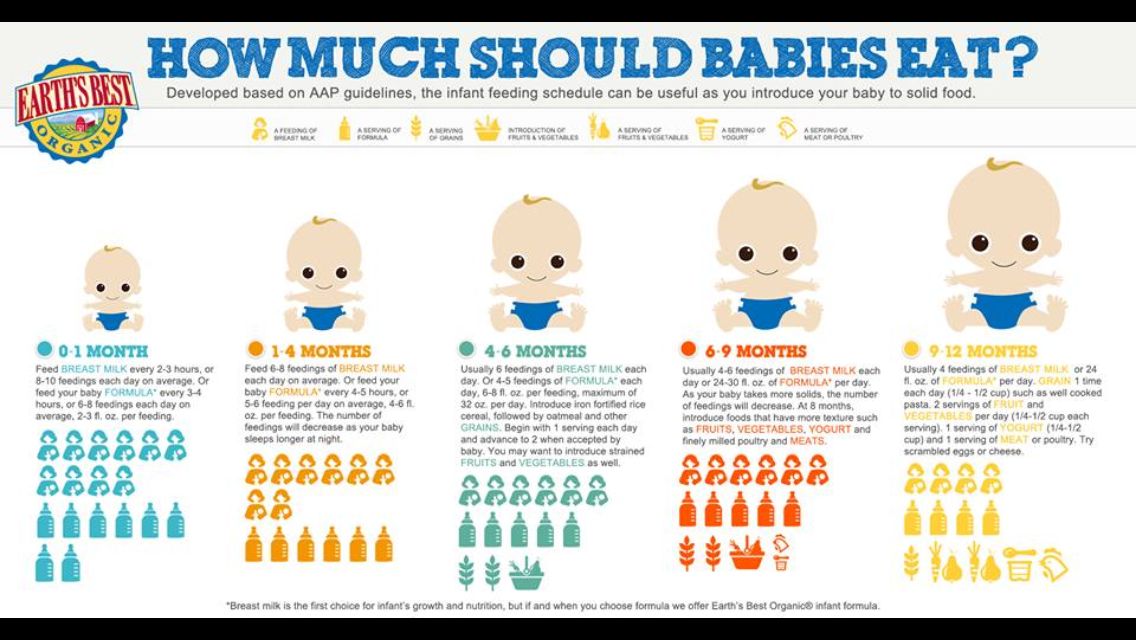
3. Give him food only when the child is hungry
A hungry child eats better, which means he will be more interested in chewing pieces of food. But again, we adhere to the "golden mean". A severely hungry baby may cry until breastmilk is given, while a satiated baby will pick and choose more familiar textures. You know your child better, so we choose the “hungry, but not too hungry” state.
4. Letting your baby feed himself
During the chewing period, children like to be independent, this is a normal stage of their development. Therefore, we use the desire of the child to our advantage. We put food on a plate and give the child a small plastic spoon. He will try to use the spoon correctly, even if it means eating finger food that needs to be chewed. Don't be upset if he only manages a few pieces. This is a pretty good start.
5. Proper serving of fruits
Children find it difficult to chew fruit well. Moreover, it is easy to choke on fruits, especially their peel.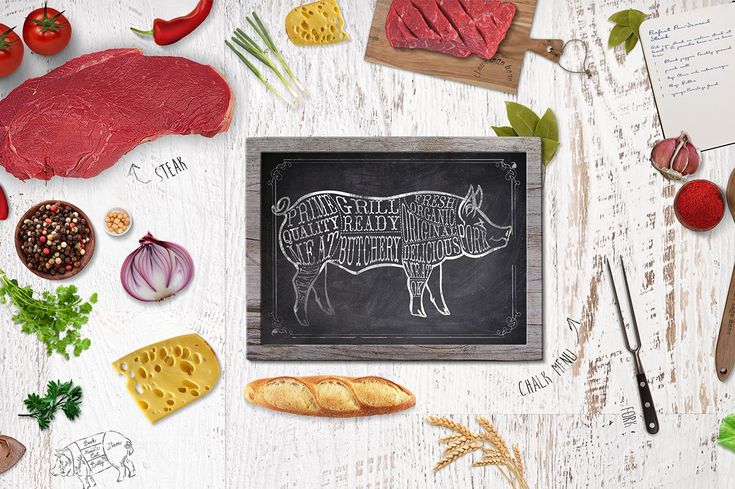 Therefore, at first we peel the fruit and use a nibbler. The child will bite and chew on the nibbler, getting the smell and taste, the juice of the fruit, and even sucking some of the puree that the child has made himself.
Therefore, at first we peel the fruit and use a nibbler. The child will bite and chew on the nibbler, getting the smell and taste, the juice of the fruit, and even sucking some of the puree that the child has made himself.
6. Cooking small soft foods
The child will grow up and any texture and consistency will be easy to chew, like an adult. But first you need to learn how to chew solid food now. And for this, we begin to give products with an easily soluble consistency. Tiny snacks that are easy to chew. Choose finger foods that melt as soon as they enter your mouth. Heat treatment makes many fruits and vegetables much softer and more tender in texture. For example, carrots up to a year are given only in boiled form, since the fresh product is too hard, it is difficult to chew, it is easy for them to choke, and it is poorly digested.
7. Allowing baby to use nibblers, baby food pouch bags
Children learn not only how to chew, but how to use their hands to feed themselves.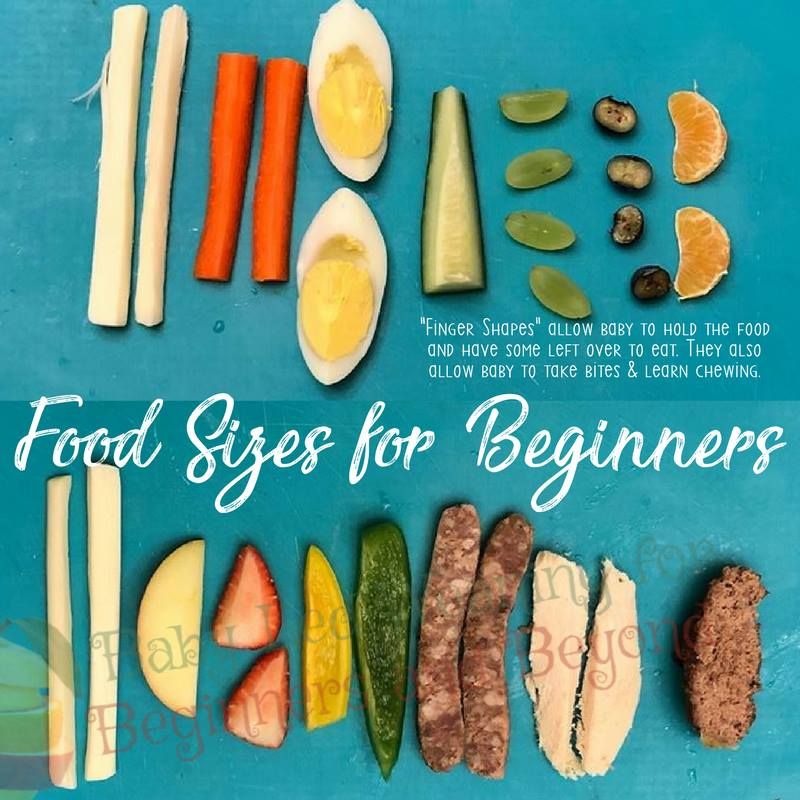 Therefore, we encourage independence and give nibler, pouch and other devices. So that the baby can not only feed himself, but also learn to coordinate the movements of the arms, head, torso, jaws, lips, cheeks, etc. The nibbler and pouch can help stimulate hand movements and give you the confidence that your baby can experiment with chewing too.
Therefore, we encourage independence and give nibler, pouch and other devices. So that the baby can not only feed himself, but also learn to coordinate the movements of the arms, head, torso, jaws, lips, cheeks, etc. The nibbler and pouch can help stimulate hand movements and give you the confidence that your baby can experiment with chewing too.
Attention, this is important
Don't be in a hurry. A child can learn to chew solid foods well, but it is not worth giving him foods such as chocolate or nuts without much practice. (I'm not talking about allergies, but texture). The simplest example. The child receives pieces of an apple without a peel, it seems that he has learned to chew these pieces, his mother was delighted, and begins to calmly give a whole apple, without peeling it. As a result, the child choked, because he does not know how to chew the peel, and it easily rises in the throat, it is very uncomfortable that the child can cough for a long time. And this is a negative experience for the child.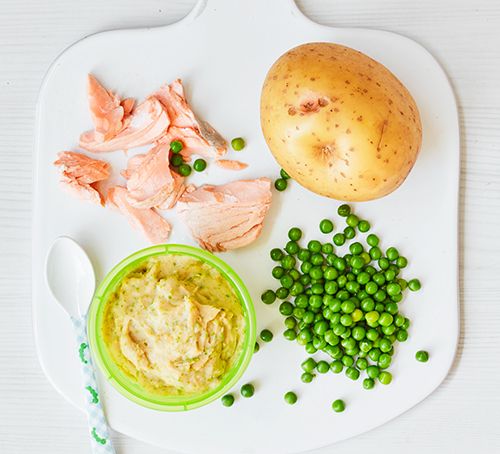 You also need to consider that some food textures can damage the gums, lead to suffocation. Also the most important rule of finger food. We give all pieces of food only in the presence of parents so that adults can help in time to remove pieces of food from the mouth. And the child's body is arranged very wisely, if the food gets in the wrong place, he begins to cough.
You also need to consider that some food textures can damage the gums, lead to suffocation. Also the most important rule of finger food. We give all pieces of food only in the presence of parents so that adults can help in time to remove pieces of food from the mouth. And the child's body is arranged very wisely, if the food gets in the wrong place, he begins to cough.
Determining the child's readiness
Teaching a child to chew is necessary after he has learned to eat baby puree from a spoon. It is important that baby opens and closes his mouth well, also digests food. Although there are exceptions, if the child is primarily fed from a tube, then work should be done to remove the tube and put the child on baby puree and liquid, and then teach him to chew. And yet, a child does not need teeth to learn to chew. Sometimes parents are afraid that the child does not chew, because he does not yet have teeth. Many babies chew and bite food at 6 or 7 months.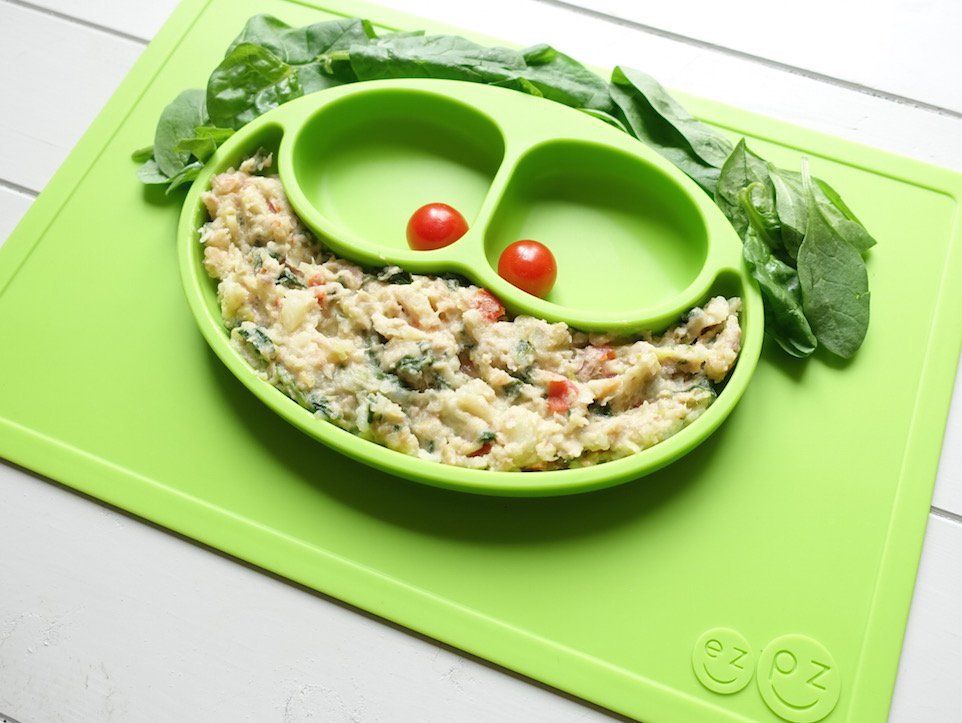
Methods and strategies
Most of the therapeutic methods that are used focus on the individual components of chewing:
- bite force and endurance
- lateral movement of the tongue
- jaw misalignment
- correct rotation pattern in the body recommendations nutrition
- A flat baby spoon must be used (see examples below).
- Take a small lump of puree with a homogeneous consistency.
- The parent is feeding the baby and should sit in front of the baby giving the verbal cue to the baby to “open your mouth”. The child should open his mouth completely for the spoon.

- Parent with one hand slightly stabilizes the head and with the other hand places the spoon halfway and then slides to the side, pulling the spoon out of the cheek. Puree is deposited on the cheek.
- lateral movement of the tongue inside and outside the mouth
- licking food from the corners of the mouth or from the back of a spoon placed in the corner of the mouth
- licking toys
- moving the tongue from side to side , and then touch the palate, trying to stretch the frenulum.
- You can buy chewing tubes or chewing instruments, which are placed on the side of the back teeth.
 The child is given a chewing tube and worked out on it 30-40 bites at a time or more. First, work is done on a dry tube, then you can dip it in puree to add swallowing. Some parents prefer to use hard textured foods like beef jerky or licorice to encourage side bite. The main thing is that the child does not have allergies, and he does not choke, so parents should be nearby.
The child is given a chewing tube and worked out on it 30-40 bites at a time or more. First, work is done on a dry tube, then you can dip it in puree to add swallowing. Some parents prefer to use hard textured foods like beef jerky or licorice to encourage side bite. The main thing is that the child does not have allergies, and he does not choke, so parents should be nearby. - Easily soluble solid food. Easily soluble foods are foods that melt in the mouth when in contact with saliva. They are easy to find in any children's store, for example, children's cookies. With the help of easily soluble solid foods, a child can also be taught to chew. Place 1 small piece on the back molars or gums with a verbal signal for the child to bite and visually show how to do it. If the child does not succeed, then we return to the crumbs placed on the side. As soon as the child can bite a piece, ask him to bite several times in a row. We give a narrow piece of cookies with verbal cues - "bite, bite, bite.
 " During training, we often alternate between biting a chewing tube and easily soluble solid food. While the child is learning to bite, firm jaw support can be added. You can feel and see the difference in bite force when the jaw is supported and when it is removed. Most children need jaw support to help stabilize the jaw and regulate bite force.
" During training, we often alternate between biting a chewing tube and easily soluble solid food. While the child is learning to bite, firm jaw support can be added. You can feel and see the difference in bite force when the jaw is supported and when it is removed. Most children need jaw support to help stabilize the jaw and regulate bite force. - Nibbler - many parents use it to bite food. You should not do this if the child does not enjoy, is not satisfied, or does not like something. A very handy thing, especially in the transition period between baby purees and finger food. The child can practice both biting and chewing.
If the child primarily suckles, then his food should consist of puree or smooth consistency and / or easily soluble solid food. A child who cannot chew should not receive finger food to be chewed. This seems like an obvious statement, but many children swallow food whole, either by holding it in their mouth or spitting it out because they can't chew. It is very dangerous to try to swallow foods that have not been properly chewed. This can lead to choking and airway obstruction, and families should always know what to do when a child chokes. Remember that a child with a delay in oral-motor skills usually has a normal or typical mouth size. This means that the child can bite his mouth, tongue, which can be a problem if the child does not know how to handle food.
Eating is a learned behavior. Sucking on solid food does not teach the baby to chew . This teaches the baby to suck food. What the child practices is what he learns. It is necessary to practice skills that will improve oral motor skills.
Side placement of puree
The first exercise to learn how to perform. This involves placing a small amount of puree (a consistency a child can handle) on the sides of the mouth, which requires their tongue to move sideways to extract the bolus. This is usually the first prechewing technique used because it starts to lateralize the tongue but does not involve the risk of choking. The technique used is as follows:
When parents start using this technique it should be introduced gradually, i.e. we feed 1-2 spoons per meal with side placement, and then, as it is convenient for the baby, gradually increase the number of spoons with side placement. This slows down the intake of food, but constant practice is crucial.
On the other hand, no one gets it right the first time, and it's harder than it looks. First, the child needs to open his mouth for the whole spoon. Therefore, parents need to use two hands, one to feed and the other to stabilize the baby's head, because the baby usually turns his head towards the spoon. And sometimes it is difficult to put a spoon neatly in the middle of the cheek.
Lateral tongue exercises
Some children find it difficult to move or control their tongue. For chewing, the child must be able to "separate" the tongue and palate. You need to teach them to move their tongue from side to side without moving their jaws. When asked to do this, children stick out their tongue and then move their entire head from side to side. There are also traditional oral movement exercises to improve tongue control. They may include:
For chewing, the child must be able to "separate" the tongue and palate. You need to teach them to move their tongue from side to side without moving their jaws. When asked to do this, children stick out their tongue and then move their entire head from side to side. There are also traditional oral movement exercises to improve tongue control. They may include:
Bite
It is very important to work on the bite to improve muscle function, strength and endurance. When a child eats solid food like an apple, he bites it 25-30 times in the same place! There are different ways to work on this:
Lateral transfer and jaw shift
When children become more comfortable with biting on solid food, work on moving food from side to side with tongue . Some children start this process automatically, while others will need help. Along with lateral transmission, jaw misalignment can also be seen. This is very important because jaw displacement is a stepping stone to adult chewing. For example, it is worth trying to chew and not move the jaws, and you can understand how difficult it is.
For example, it is worth trying to chew and not move the jaws, and you can understand how difficult it is.
Massage and gymnastics
Activities to maintain body stability, spinal muscle strength and range of motion can have a positive effect on oral motor skills. Pay attention to Head and neck alignment, especially when chewing . If the child does not sit properly, then this can affect the position of the tongue, making it difficult to transition to chewing. Therefore, it is so important for the first year to do daily gymnastics to strengthen the baby's muscles, to allow him to crawl and walk a lot, so that the muscular frame is naturally strengthened.
Verbal and visual cues
During chewing practice, parents should give the child verbal signals to “open”, “bite”, “crunch”, “bite like a tiger”. It is also important to lead by example, chew and bite with an exaggerated movement of the open mouth. Chew with your mouth wide open so your child can see the adults bite and then show them how the tongue moves the food through the mouth to the other side. Many children will imitate.
Many children will imitate.
Reduce sucking
For some children avoiding bottle and pacifier sucking is a way to avoid any sucking the baby is doing. Just change the pacifier and bottle for a cup. But this does not mean that you need to get rid of breastfeeding, children perfectly combine breast sucking and complementary foods up to 2-3 years.
I was very careful with my older child . Since I am one of the panicked moms, my first experience with introducing solid food into my baby's diet was very neat . At about 9-10 months, I began to give the baby cookies that melted in the mouth, then I introduced an apple, then boiled vegetables. The older child was choking at first, as a result, I had the feeling that my fingers were constantly in the baby’s mouth, and I was constantly pulling out all sorts of filth from there. But it normal. Children under 2 years old constantly keep their fingers in their mouths, suck, bite, chew something.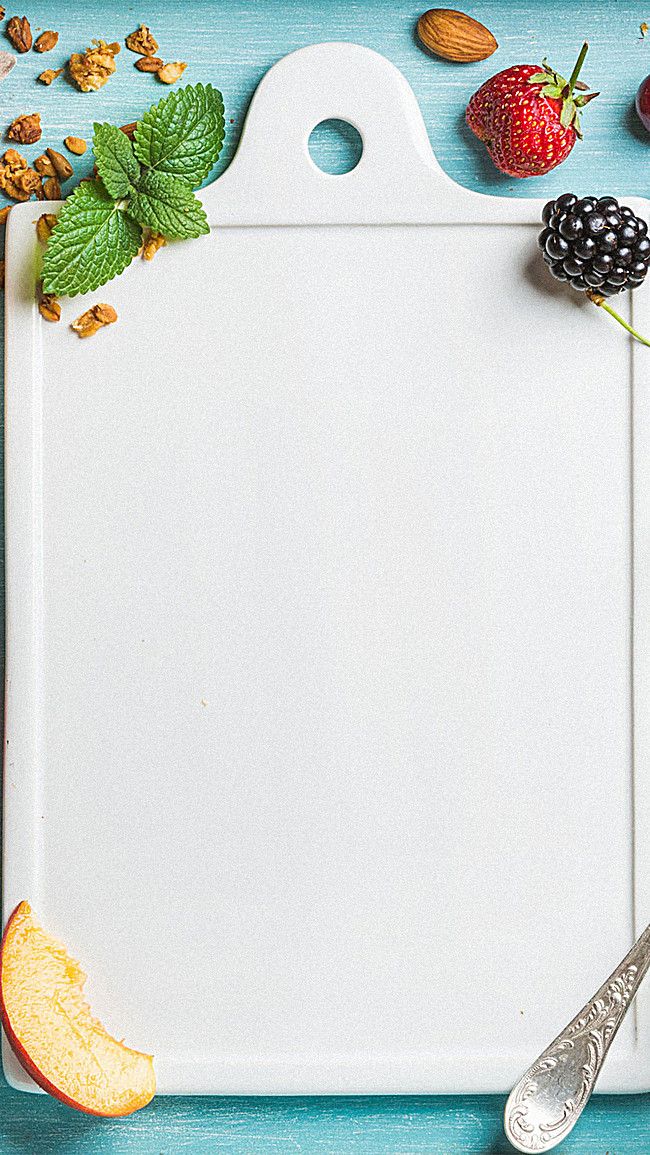 If mom does not give food, then he chews toys, that's good. We had a lot of teether toys, but we got quite unusual old Soviet rubber hedgehogs and balls .
If mom does not give food, then he chews toys, that's good. We had a lot of teether toys, but we got quite unusual old Soviet rubber hedgehogs and balls .
With a younger child, a nibbler was used as a transition point before moving on to food pieces. I liked it, the experience of switching to finger food with a younger child is described in the articles, I will not repeat it.
Honestly, I didn't teach my kids to chew. They learned by themselves, it's a natural process. Until a certain moment, I did not even think that the problem of learning to chew is so serious.
A few of my thoughts, why did our chewing training period pass so imperceptibly that there was no problem.
Because of the fear that the baby would start to choke, I introduced finger food into the baby's complementary foods very carefully. The age of administration may be different, but approximately as pediatricians advise 8-10 months. We look at the readiness of the child, at his desire. Usually, if the baby starts to climb into the plate and successfully grabs and brings the pieces to his mouth, then we can say there is a desire and readiness. Some babies start doing this as early as 7 months, so don't rush, wait until 8-9 months. Since the baby needs to learn how to manage baby puree in his mouth.
We look at the readiness of the child, at his desire. Usually, if the baby starts to climb into the plate and successfully grabs and brings the pieces to his mouth, then we can say there is a desire and readiness. Some babies start doing this as early as 7 months, so don't rush, wait until 8-9 months. Since the baby needs to learn how to manage baby puree in his mouth.
I don't like natural complementary foods because they skip the baby puree stage. For me, everything should be gradual and timely. So after the liquid, it is more logical to start giving a thicker liquid, then thicker and thicker, then move on to a piece texture. In a couple of months, a child learns to manage liquid and thick puree, and then when pieces are given, the process simply becomes more complicated, but it is not new to him, but simply became more difficult, which is very good, interest in food is maintained.
Let's think about how babies learn to suckle. It seems to be a natural physiological process, but at first the child gets tired, someone falls asleep, someone screams heart-rendingly, because he wants to eat, but there is simply no strength to apply milk. And if you give a child a bottle, he will easily eat it, no effort is needed. It is easy to switch to artificial nutrition, but staying on the breast is difficult not only for the mother, but also for the baby.
And if you give a child a bottle, he will easily eat it, no effort is needed. It is easy to switch to artificial nutrition, but staying on the breast is difficult not only for the mother, but also for the baby.
Therefore, pediatricians require the correct selection of a nipple for feeding with artificial feeding, so that the baby's jaws work. This is a training of the muscles of the maxillofacial apparatus, these same muscles will later participate in chewing. A little different, but they will. When a child is fed through a tube, he flatly refuses to breastfeed when his condition improves, he yells “good obscenities” because he is hungry.
The mother's role at this moment is not to panic and continue offering breasts. Remember that this takes time and all the strength of the mother. Well, if there are helpers, and if not, a couple of sleepless nights are provided. My experience is two days , that's how much it took for a weakened child to completely switch to the breast with a complete rejection of the mixture.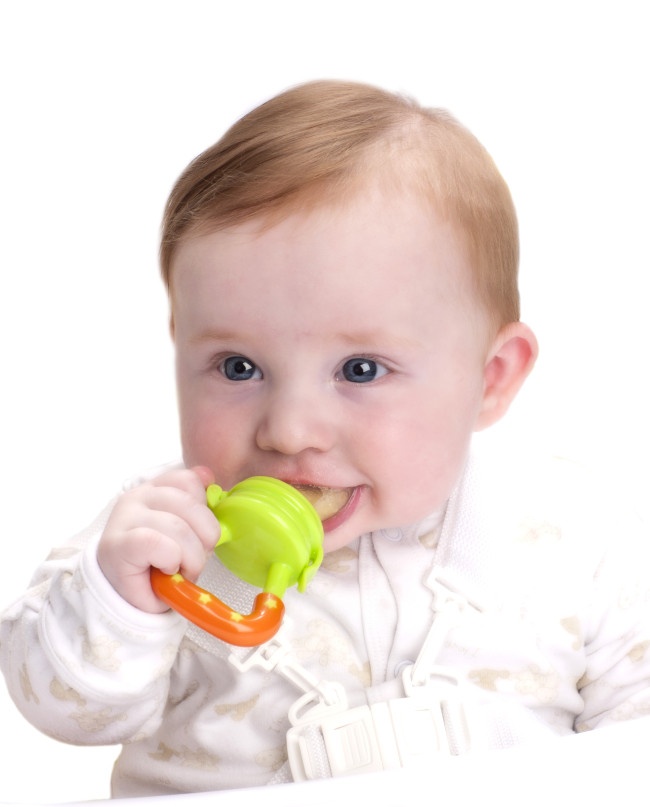 Alternating and supplementing in our case did not help, the child did not take the breast, preferring the bottle.
Alternating and supplementing in our case did not help, the child did not take the breast, preferring the bottle.
And why am I writing this. And the fact that everything happens smoothly. Up to 6 months or before the introduction of complementary foods, the child trains the maxillofacial apparatus by sucking, then with the introduction of complementary foods in the form of liquid purees, the training continues, but the tongue, palate and cheeks are connected, the baby trains for a couple of months. Then, as the child begins to manage liquid food well, lumpy liquid food appears in his diet, then they begin to give food in small pieces, then in larger pieces, and at the end we offer a whole product for the child to bite, chew, and swallow. This is a natural transition from sucking to chewing.
All the exercises described above are more suitable for children who, for various reasons, have not learned to chew. Then parents have to make efforts to teach the child to chew.
If everything happens in time as the child is ready to chew, without stress and frightening moments, such as biting off, choking or coughing for a long time with a sore throat or vomiting due to illness or a piece of food, etc., then the child will learn to chew without anyone assistance, as this provides for its natural development.
Another very important point is family meals, when the child watches and learns. It doesn’t matter how you plant him, the main thing is that he sees that his mother bites, chews, and swallows food. It is at these moments that the main thing is not to scare the baby away from studying his mother's plate on his own. If you think it's too early for your child to try finger food, then organize your plate food accordingly, i.e. mashed potatoes or lentil puree or cream soup with soft croutons, etc. It is very important to keep the child's interest in food so that he finds the process of eating interesting and curious.
Don't be afraid of special baby accessories like a nibbler, it helps a lot in the transition period.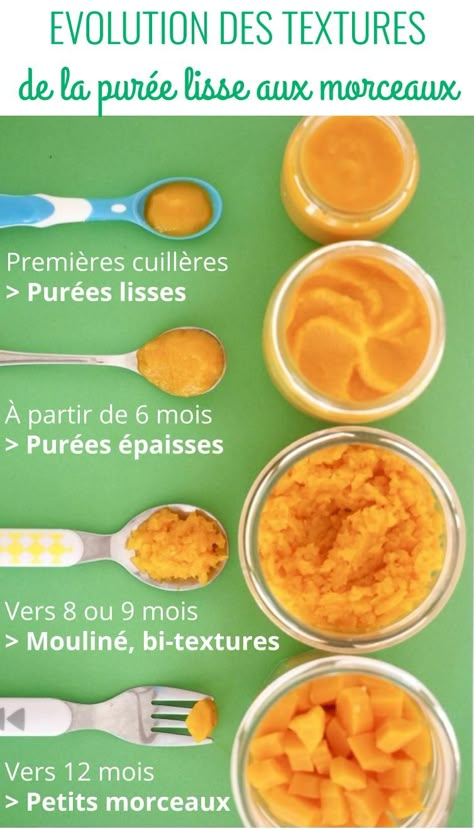 At least the panicked soul of the mother is sure that the child will eat and not choke.
At least the panicked soul of the mother is sure that the child will eat and not choke.
From the age of 6 months it is necessary to teach the child to drink from a mug . I wrote about a convenient mug in an article. The ability to drink water from a mug is the ability to speak the language, as soon as he learns to drink without choking, then you can think about the pieces. But again, let's not get hung up, there are children who learn to chew before they drink, this is also the norm.
Letting baby chew on safe toys , books, fingers, anything he can get his hands on and whatever mom thinks he can chew. This is a learning process, forbidding, we slow down the development of the child. He will unlearn chewing objects over time.
Playing with baby , use facial expressions to make the baby repeat. Especially the facial expressions that are responsible for the work of the jaw, cheeks and lips. Nothing complicated, we remember the favorite games of babies, in aha, ay, cuckoo, for older children we play games - smell a flower, brush your teeth with massage of the tongue and cheeks, click your teeth at least 20 times. Correct chewing also requires proper breathing, I like Buteyko exercises, but this is suitable for children from 4 years old. For younger children, you can learn to blow light balls / feathers from your hands with your nose, one nostril, also blow on a feather so that it stays in the air, etc. We also encourage colloquial speech, i.e. for children under one year old, we rejoice at the words la-la, tu-tu, yes-yes, i.e. all the syllables in which the tongue, lips and cheeks work, a very useful practice for future chewing. Just sing a stupid song:
Correct chewing also requires proper breathing, I like Buteyko exercises, but this is suitable for children from 4 years old. For younger children, you can learn to blow light balls / feathers from your hands with your nose, one nostril, also blow on a feather so that it stays in the air, etc. We also encourage colloquial speech, i.e. for children under one year old, we rejoice at the words la-la, tu-tu, yes-yes, i.e. all the syllables in which the tongue, lips and cheeks work, a very useful practice for future chewing. Just sing a stupid song:
The radiant sun smiled cheerfully
Because we sang a song with Mashenka
Buteyko breathing exercises. CLICK ON ME!!!
You can also buy pipes, harmonica, whistle, etc. and allow to use constantly, also a good muscle training, also air bubbles.
You can teach your child to yawn widely and click his tongue. Have you noticed that I write ways that indirectly help improve chewing.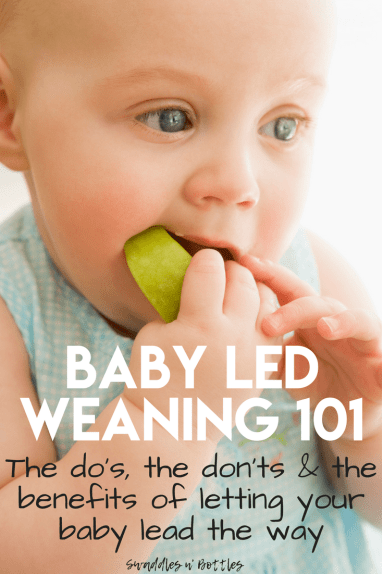 We play these games with a child from birth, he just got home after the maternity hospital, and his mother, look here - peek-a-boo. I am not writing anything new, everything is as old as the world. Just now you will know why adults play these games with children. And all the games for breathing and the development of the throat muscles are a good prevention of adenoids. Therefore, we sing more songs with the baby, let him rejoice.
We play these games with a child from birth, he just got home after the maternity hospital, and his mother, look here - peek-a-boo. I am not writing anything new, everything is as old as the world. Just now you will know why adults play these games with children. And all the games for breathing and the development of the throat muscles are a good prevention of adenoids. Therefore, we sing more songs with the baby, let him rejoice.
And lastly, let the child study calmly, do not rush, do not help, do not touch. He digs in a plate for an hour, so it’s necessary, let him dig. You definitely won’t remain hungry, especially if the baby is breastfed.
My advice is simple. A personal example of chewing, a gradual complication of the consistency of food as the child is ready to move on to more complex options, from 6 months to learn to drink from a mug, play with the baby, do not rush him, use toys and various children's chewing tools, such as teethers, nibbler, spider, toothbrushes, etc.